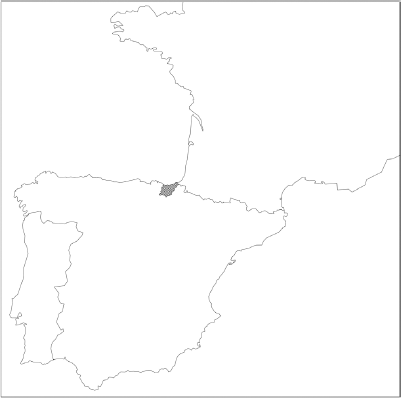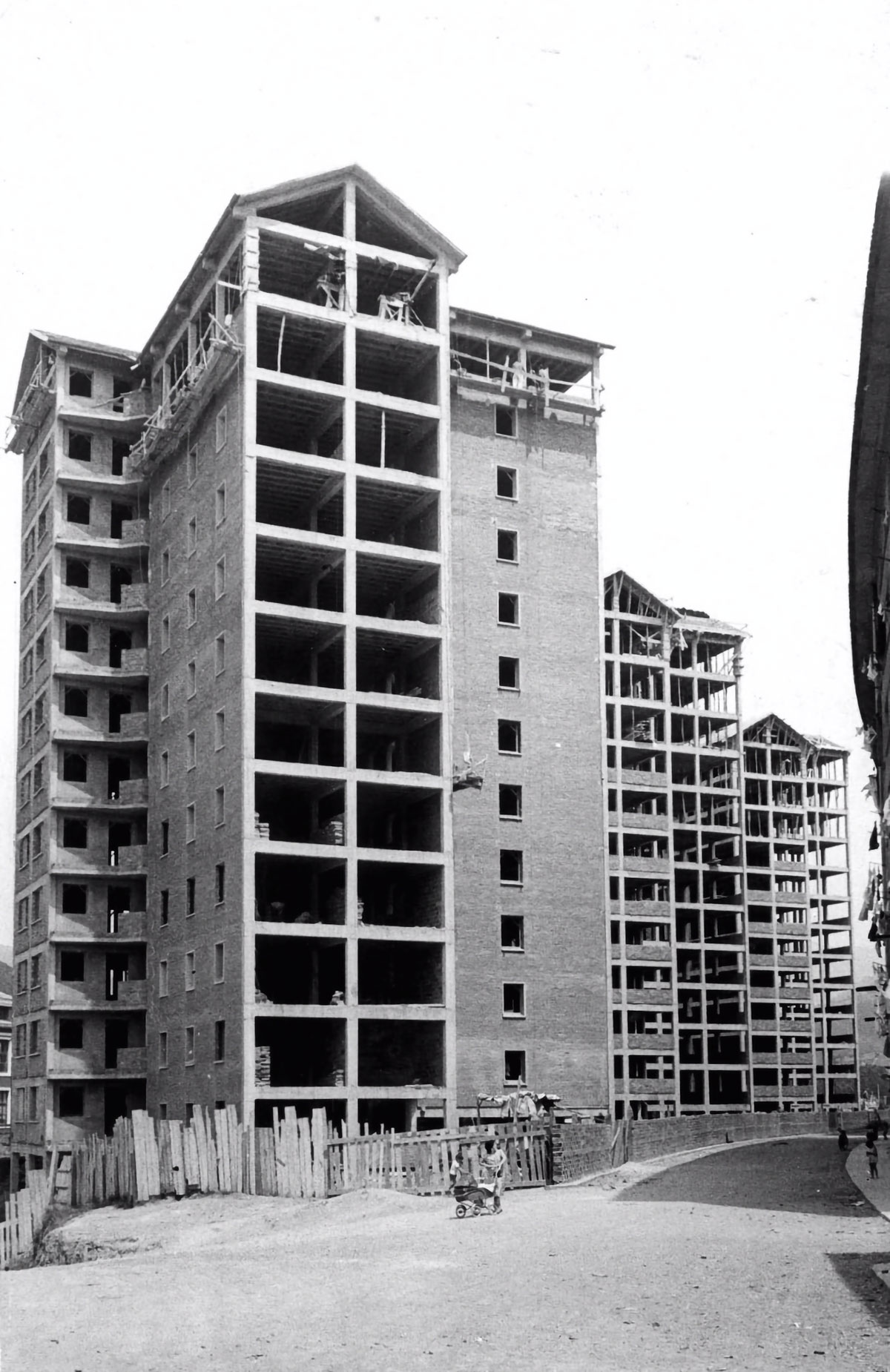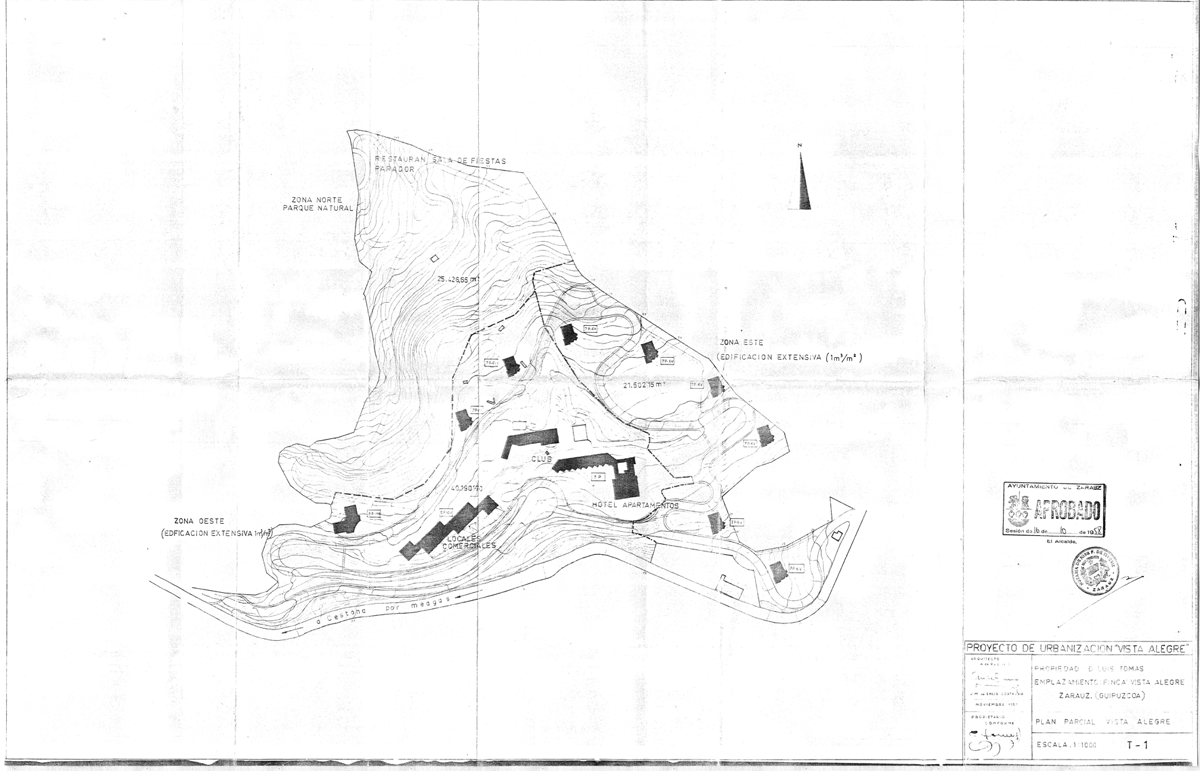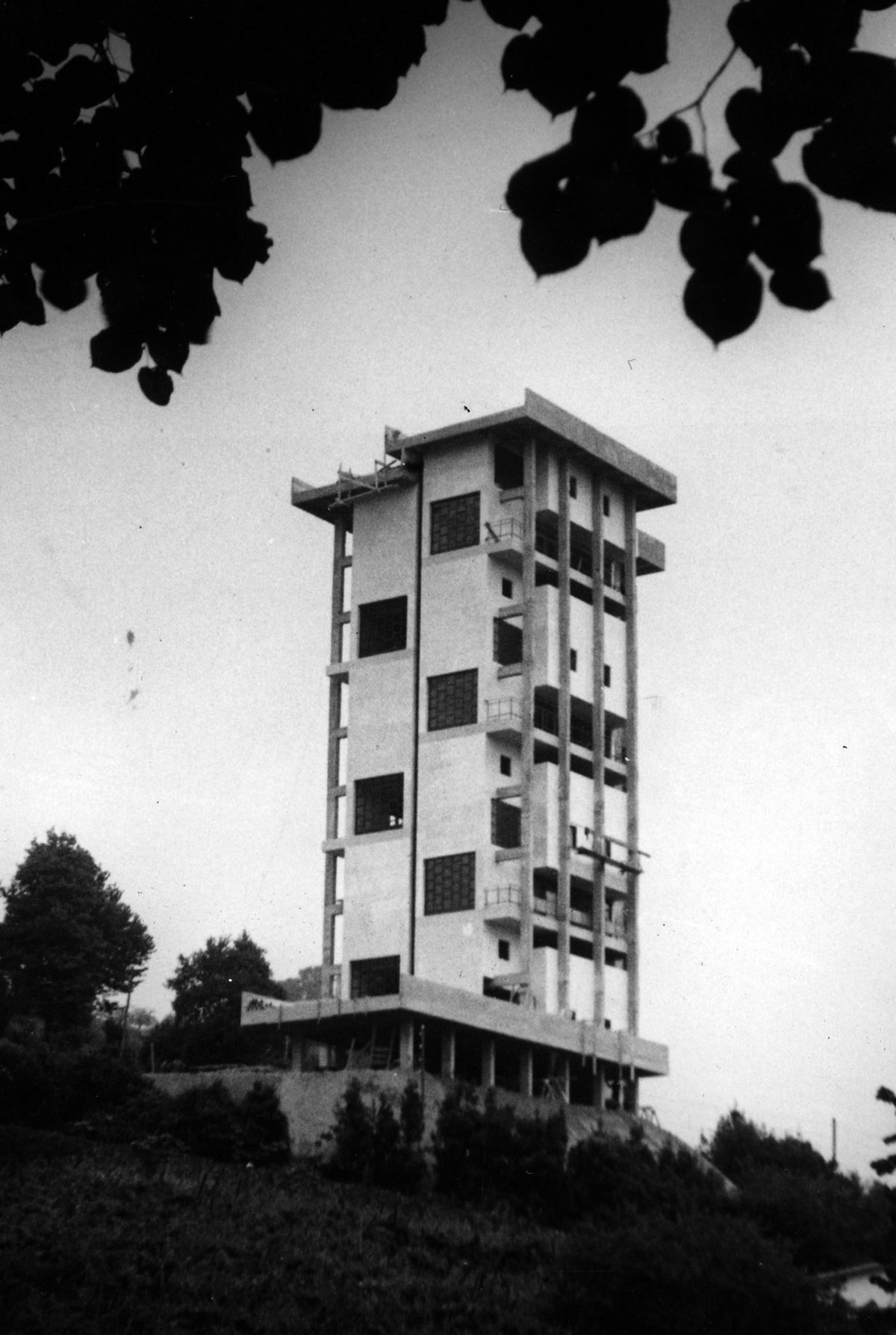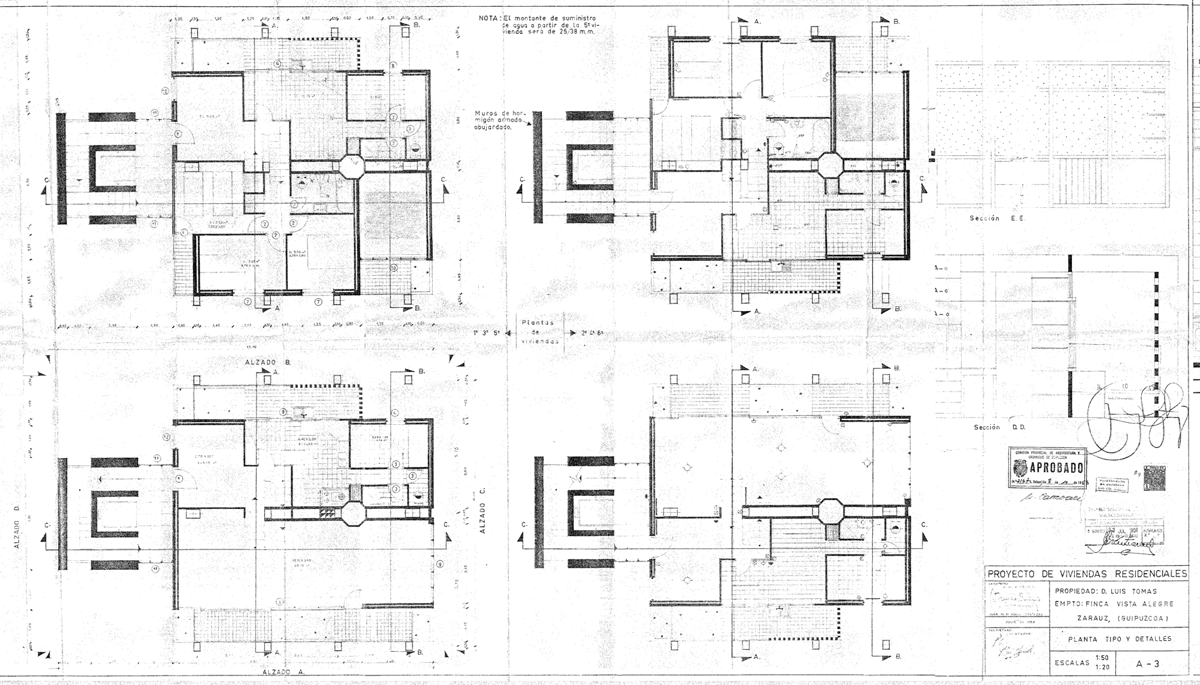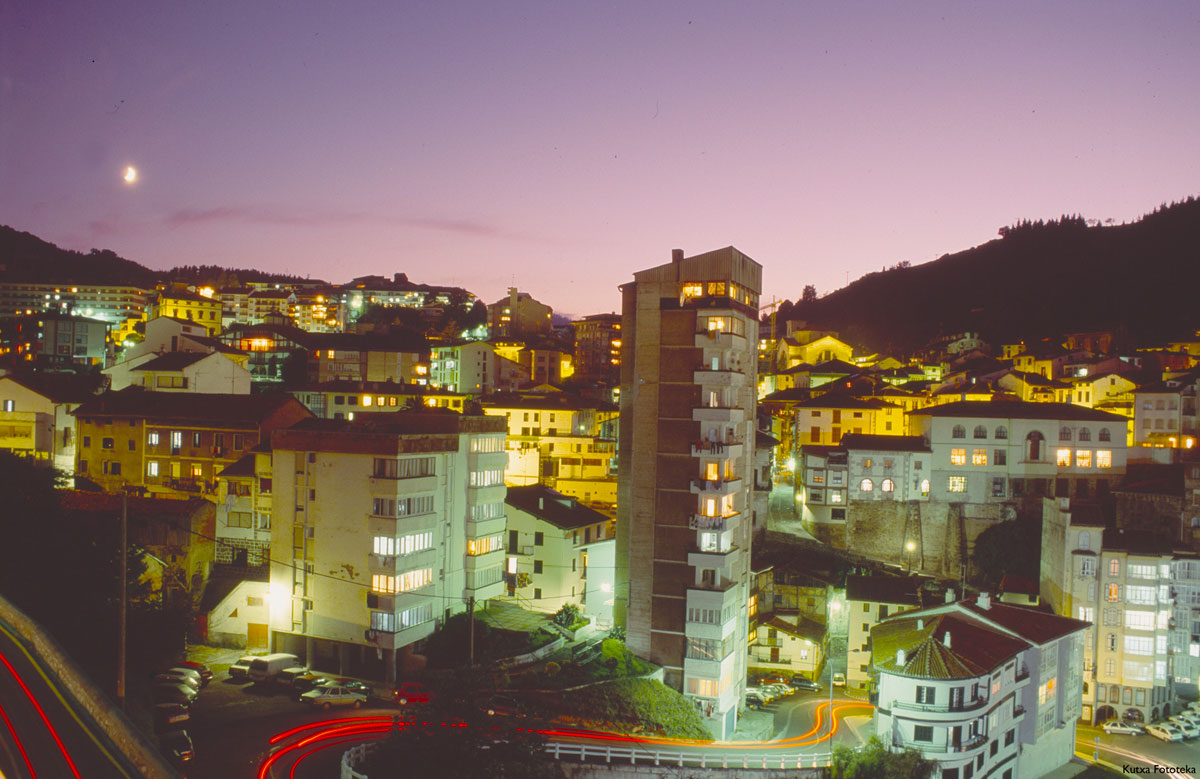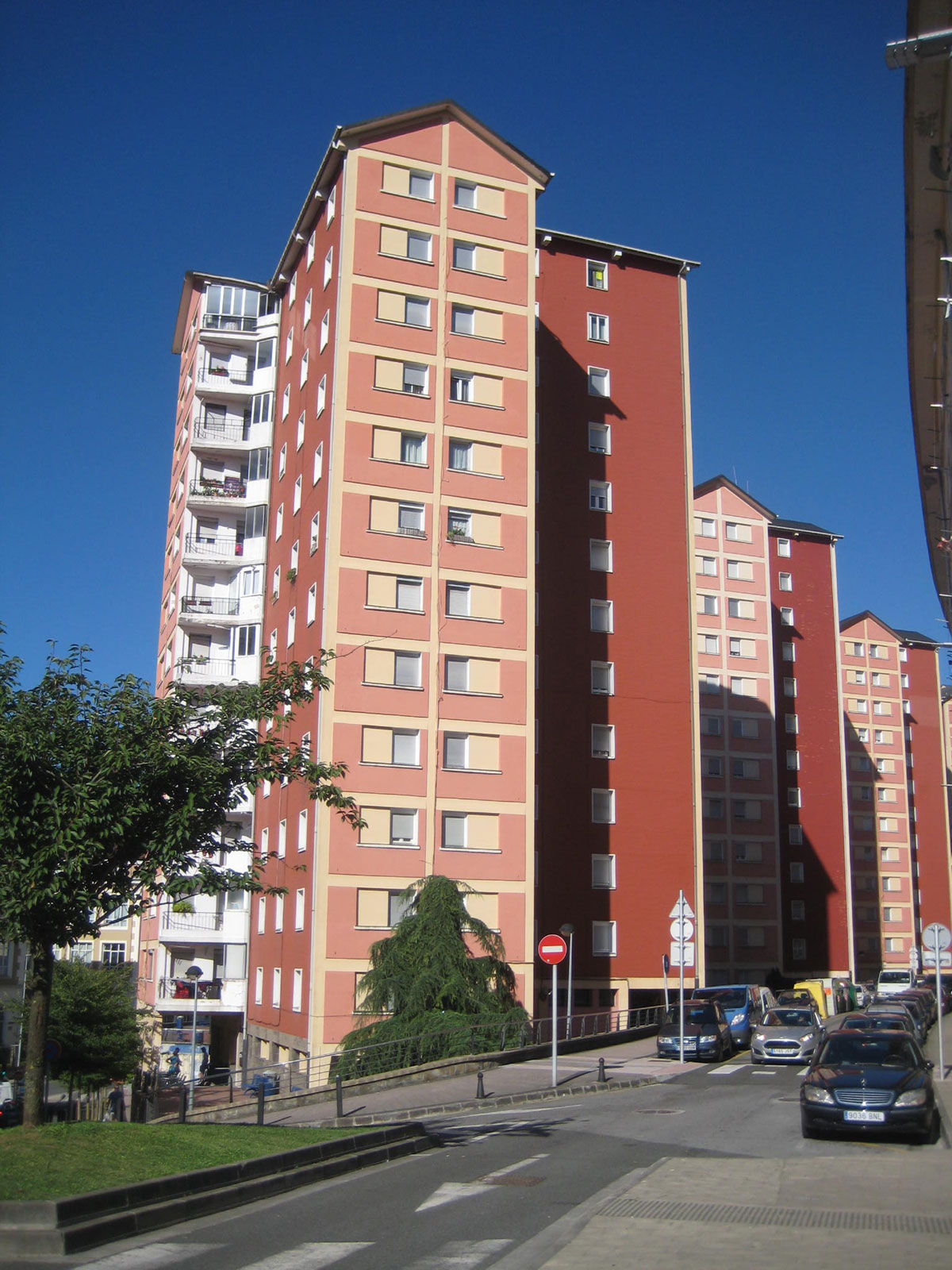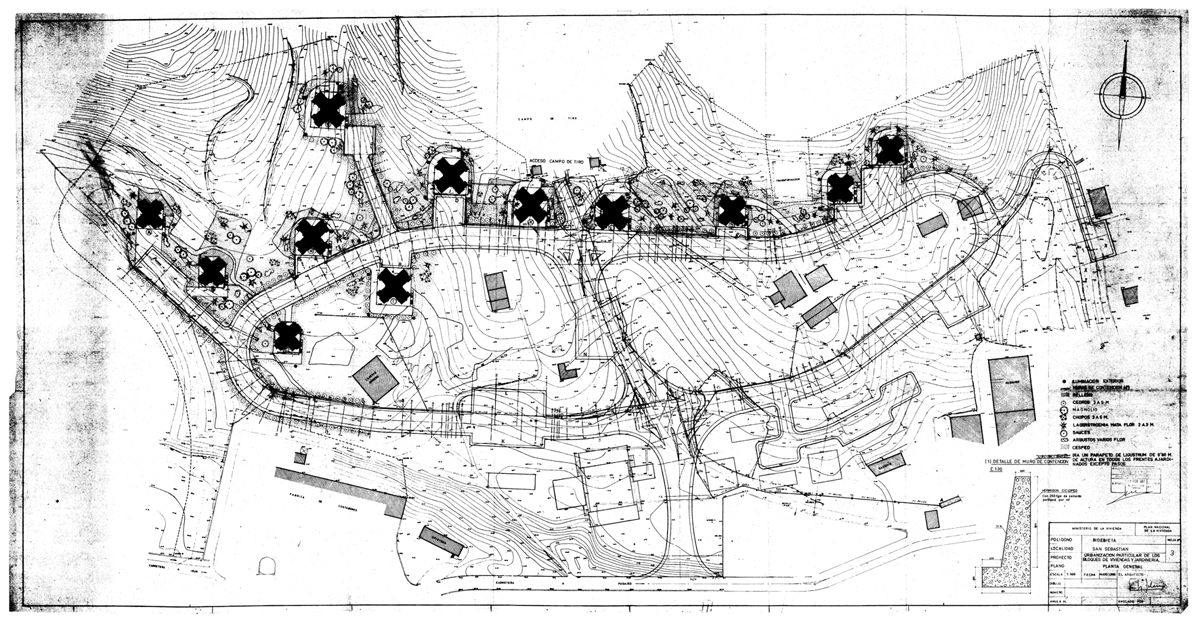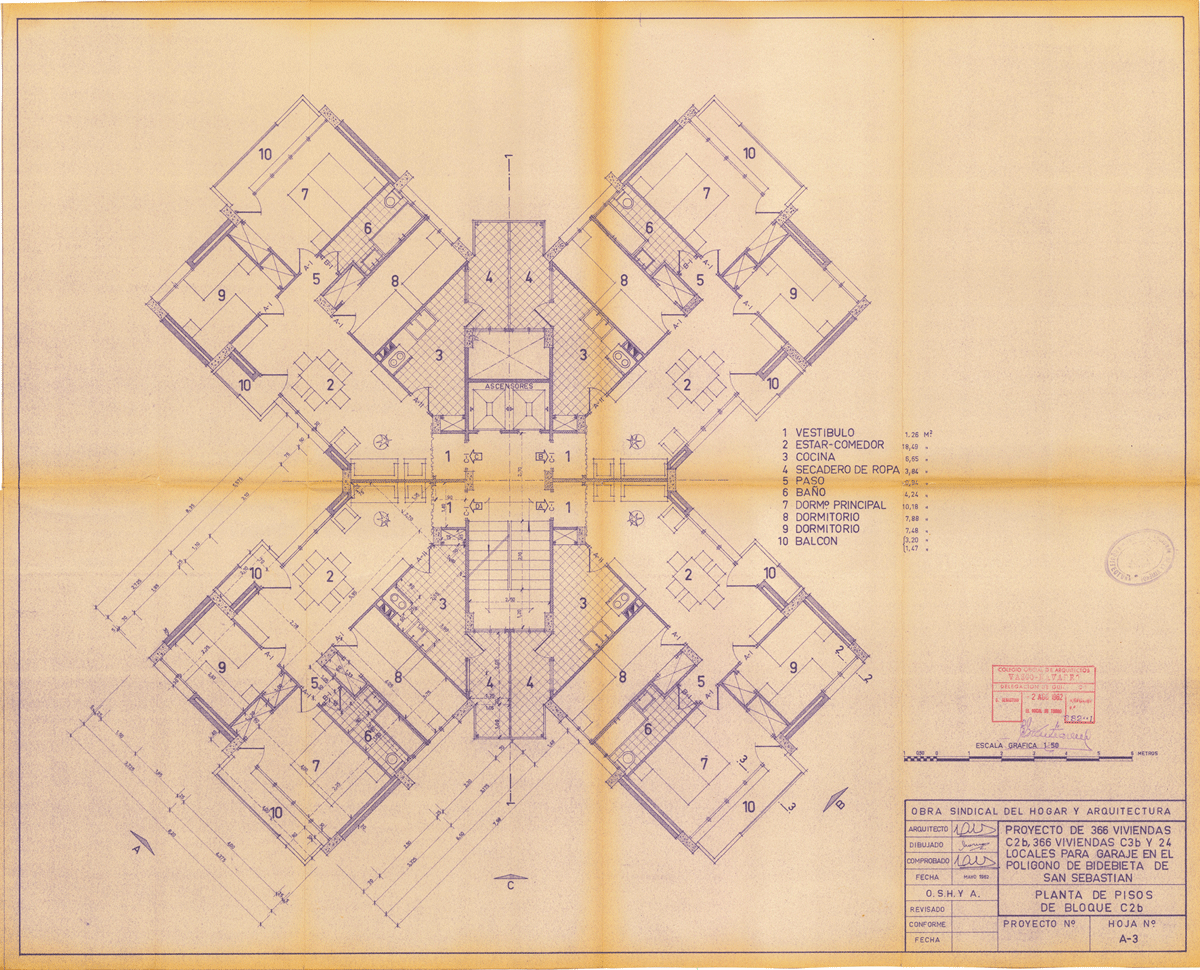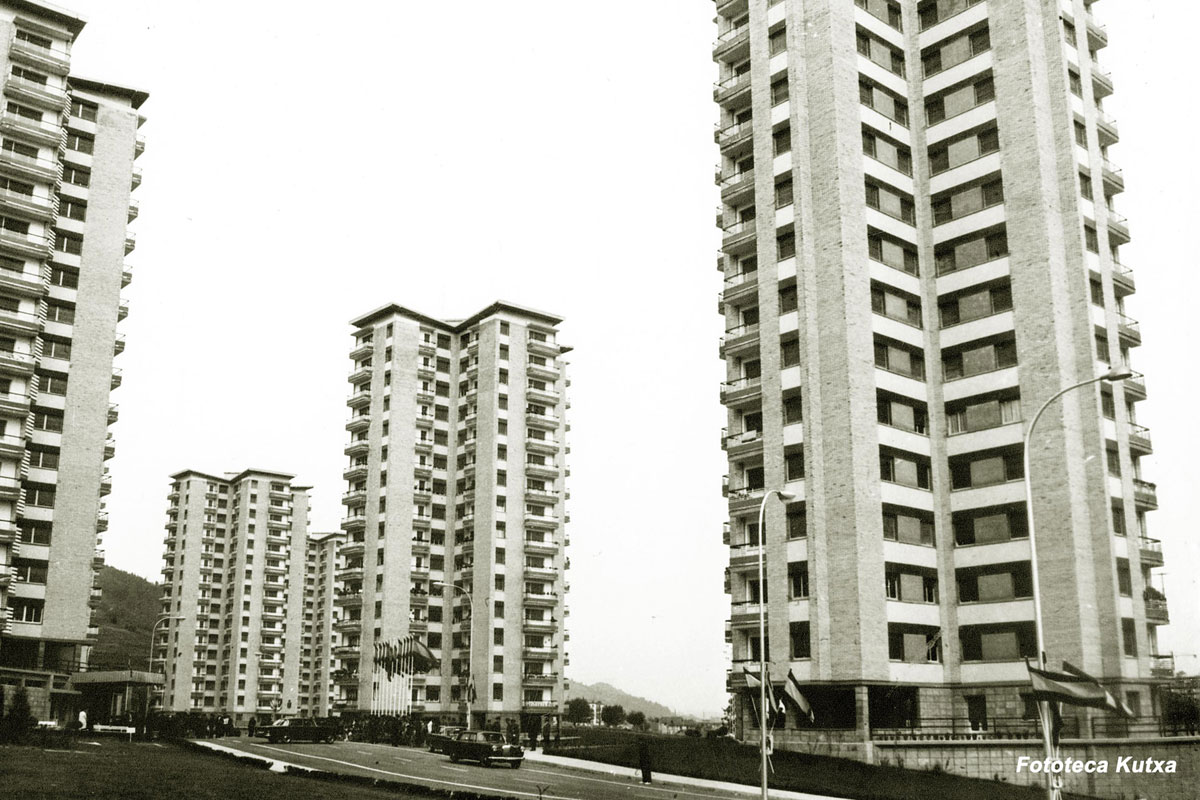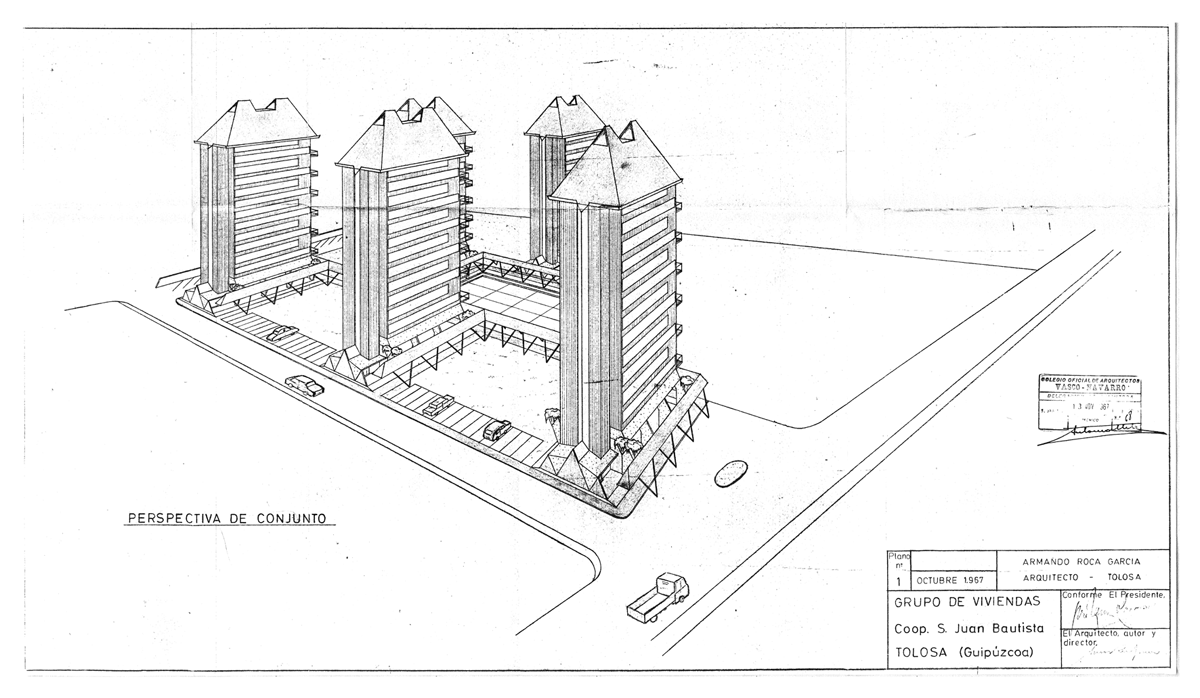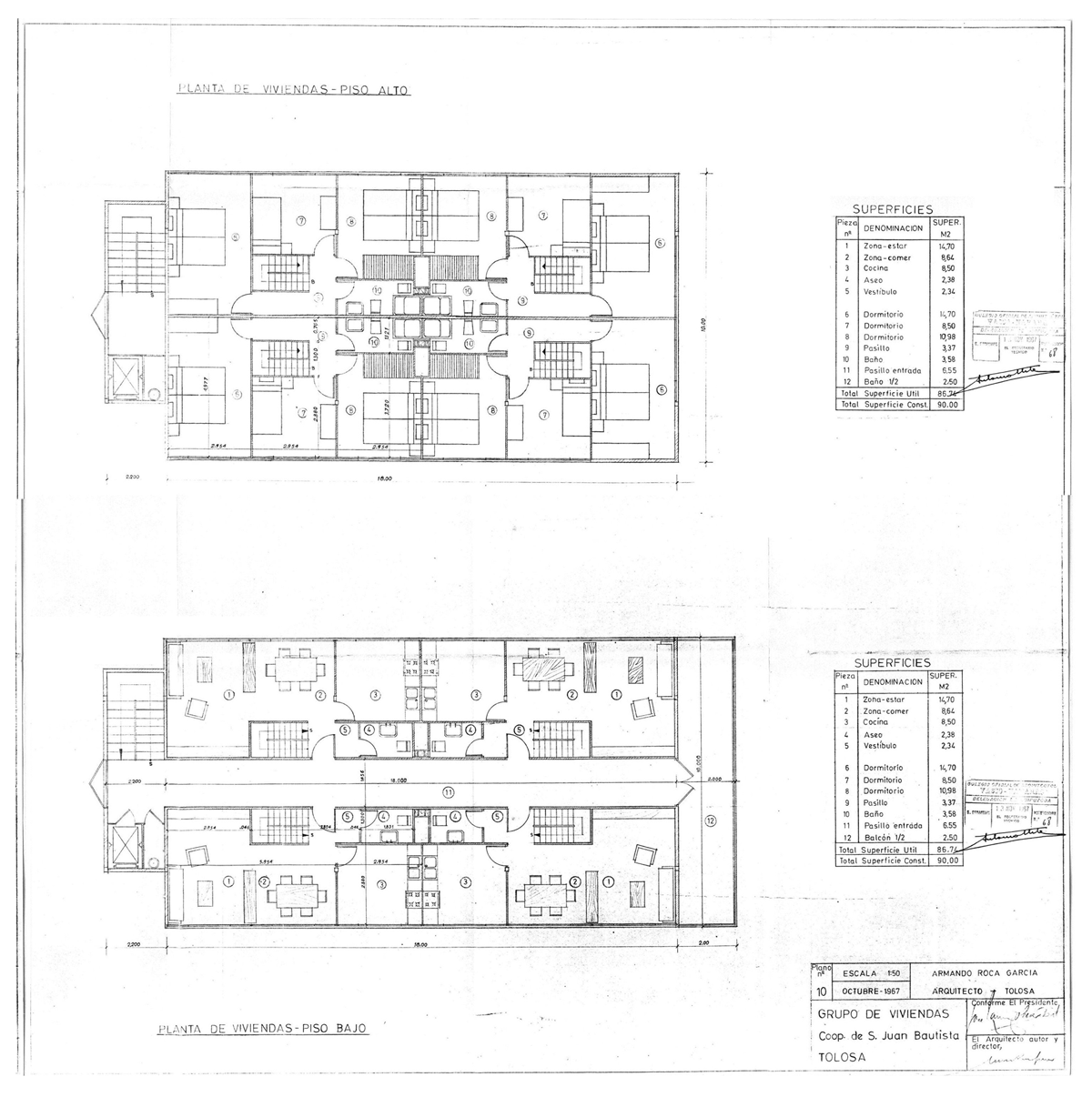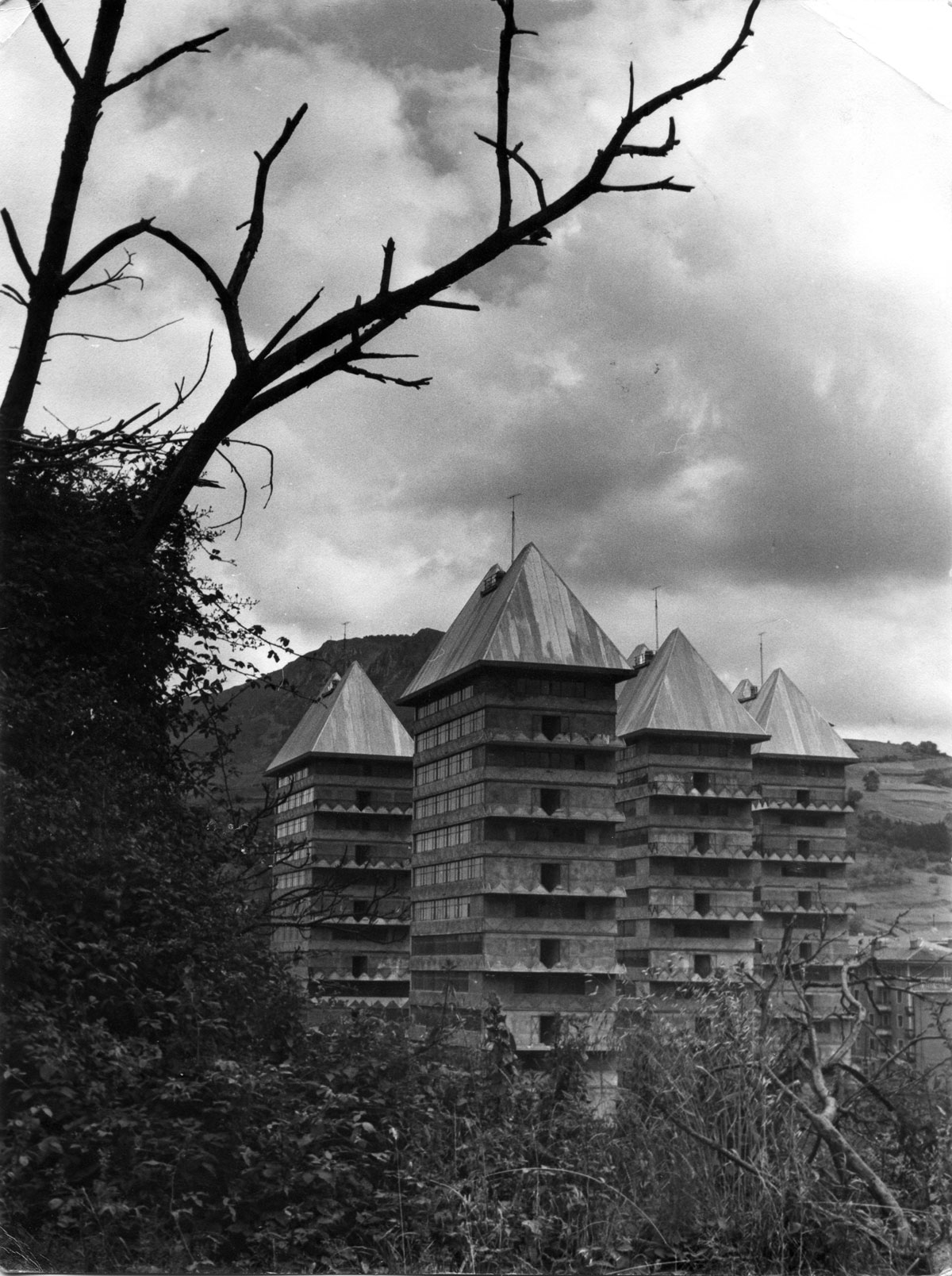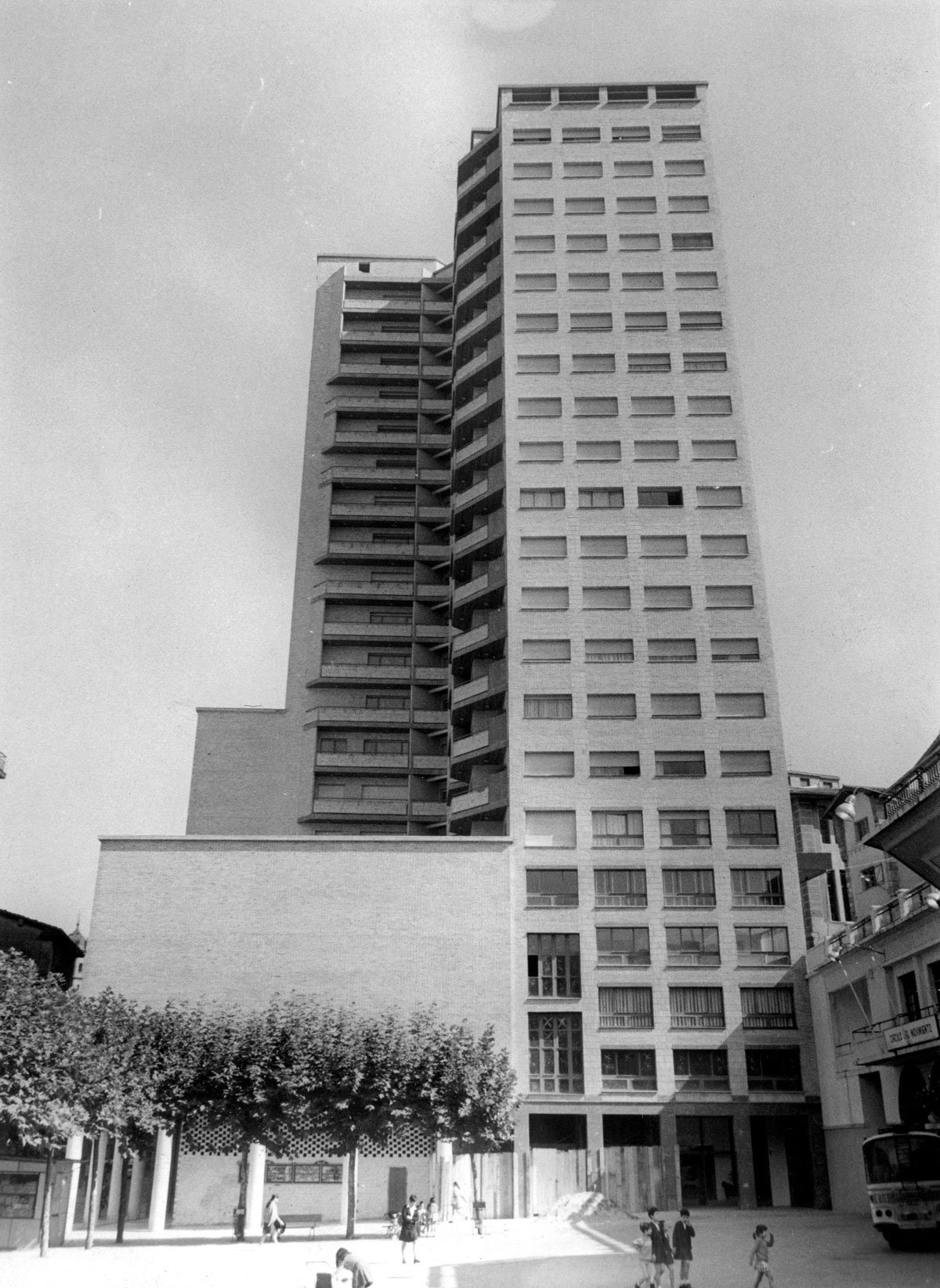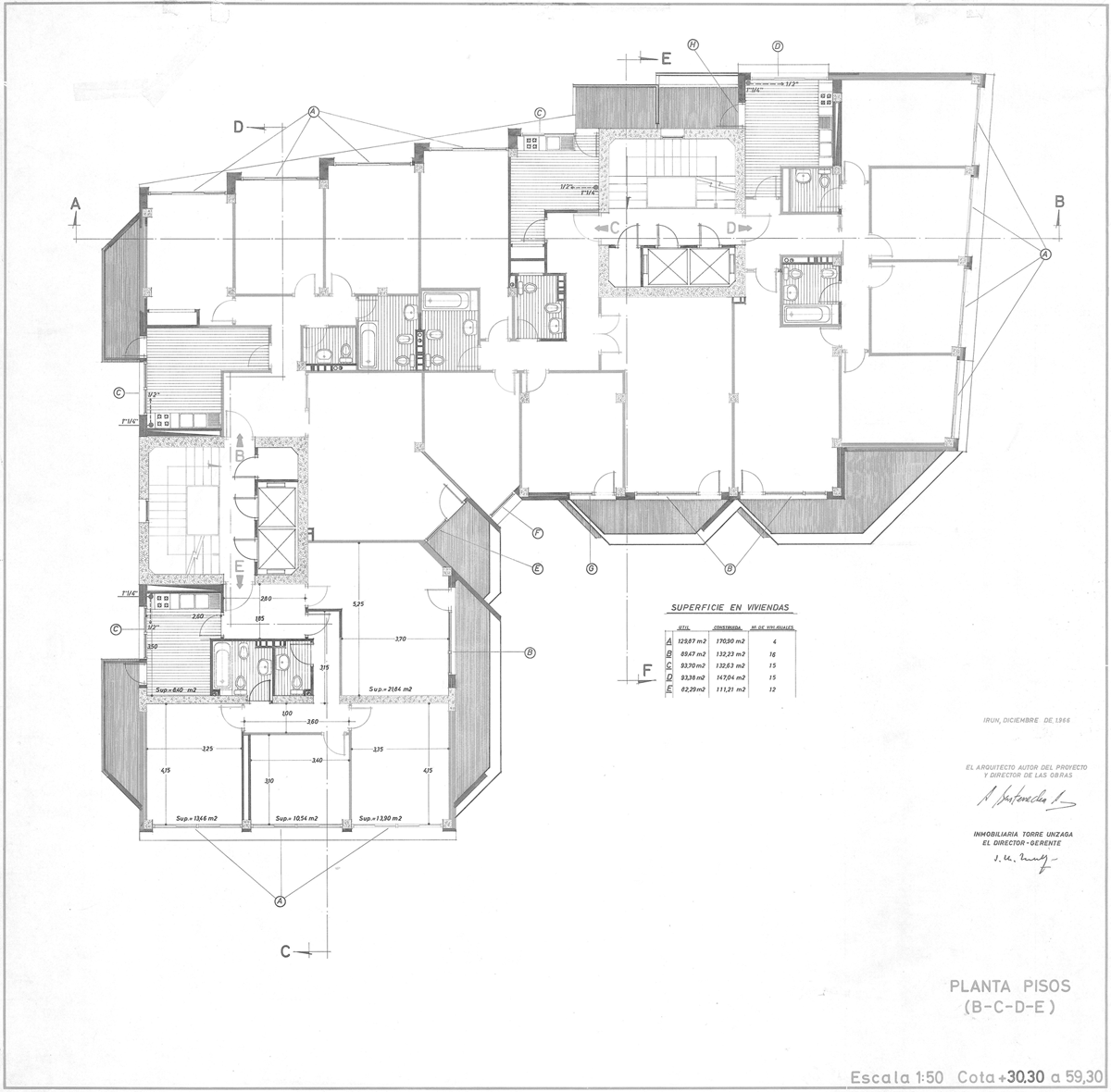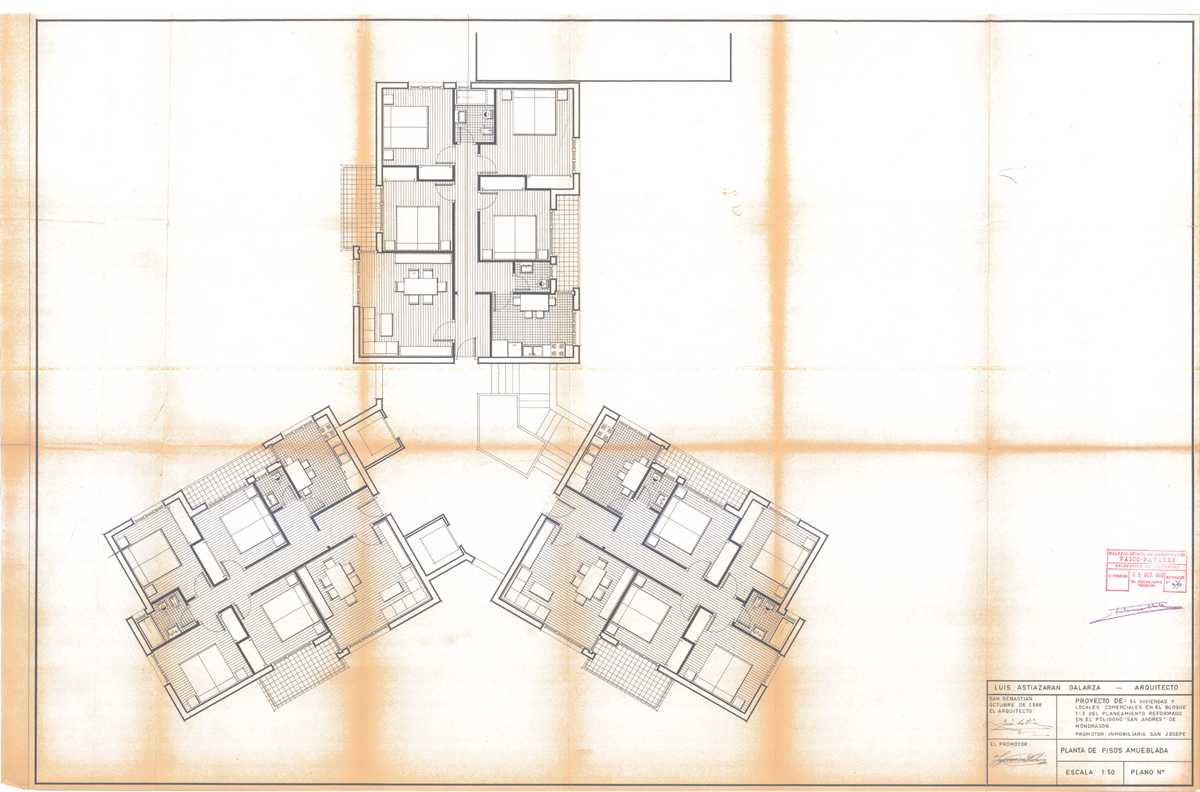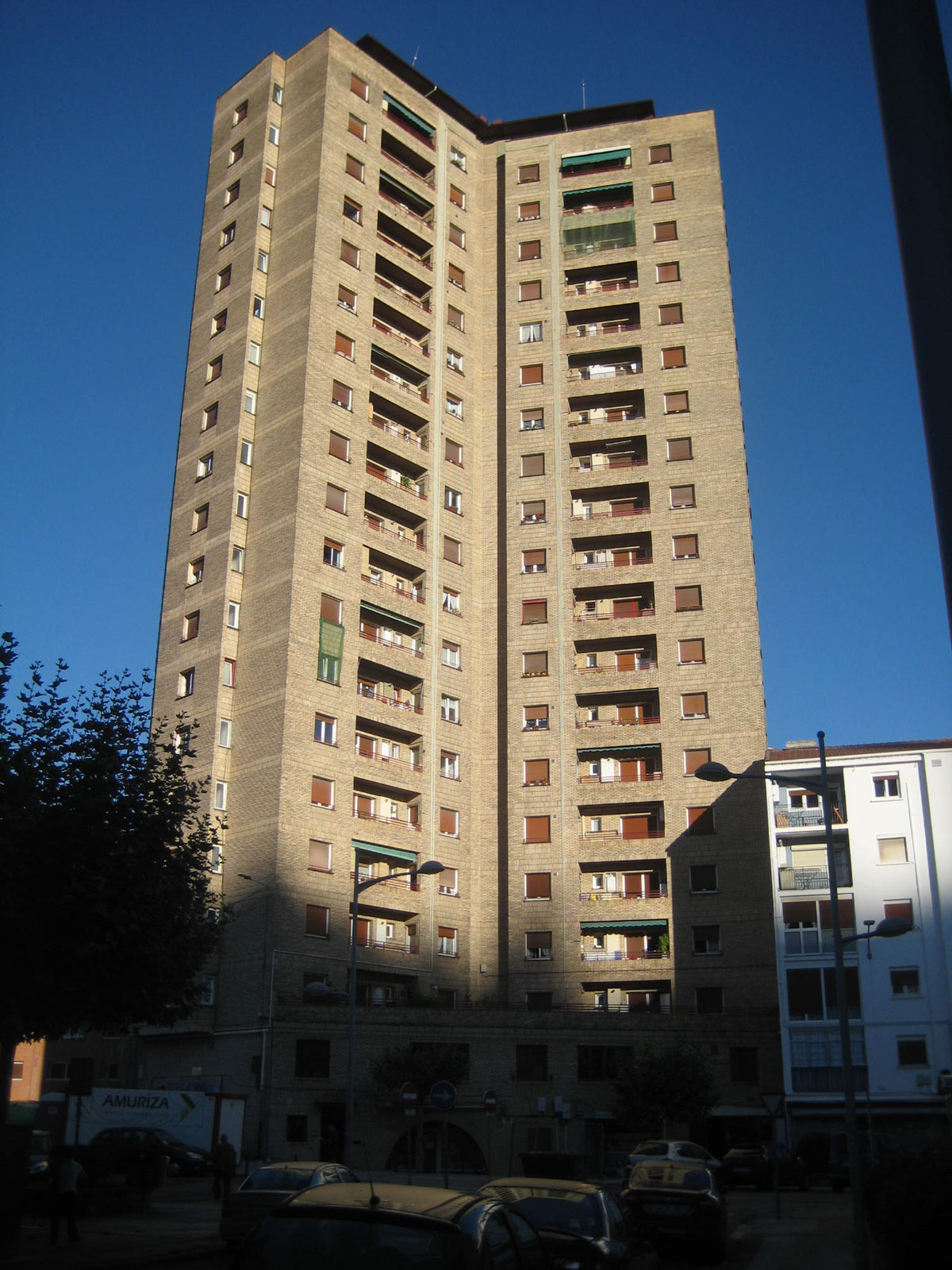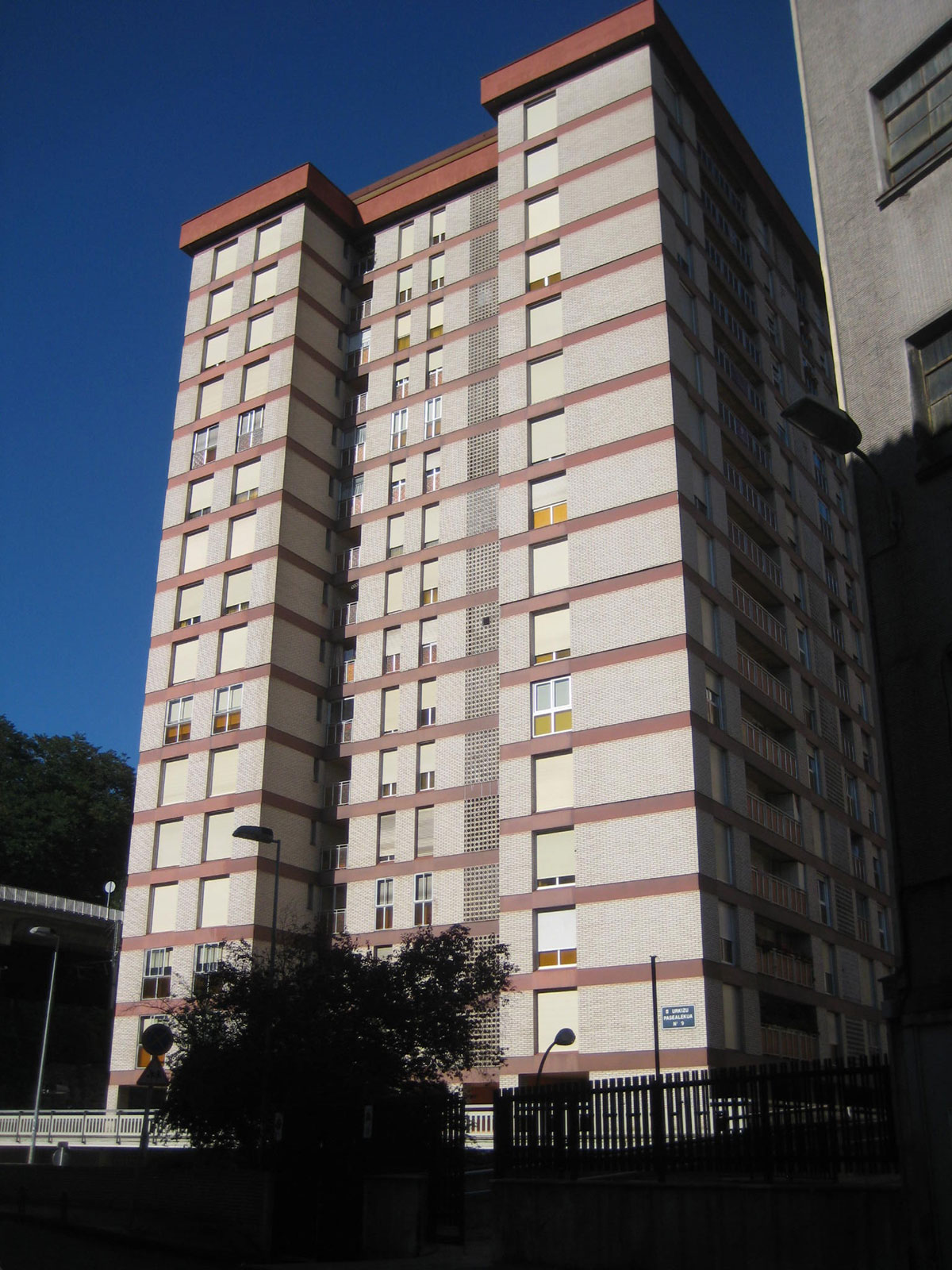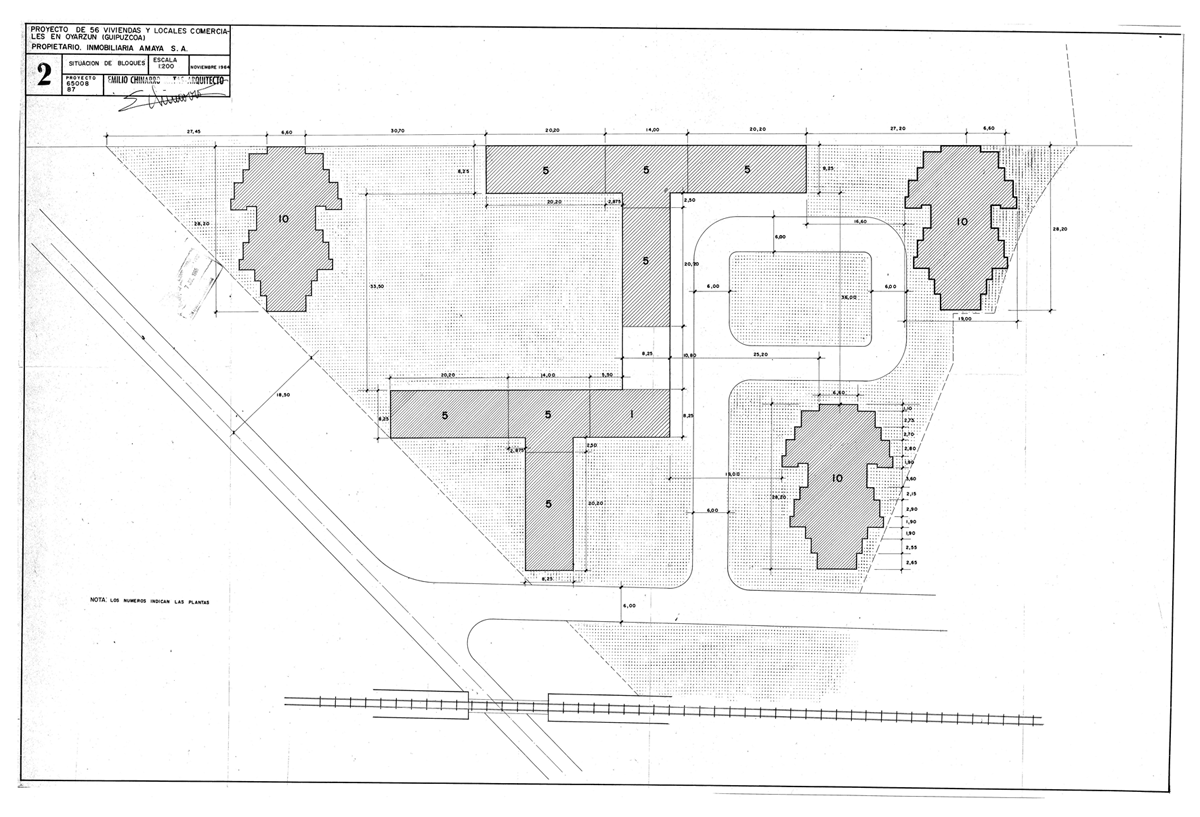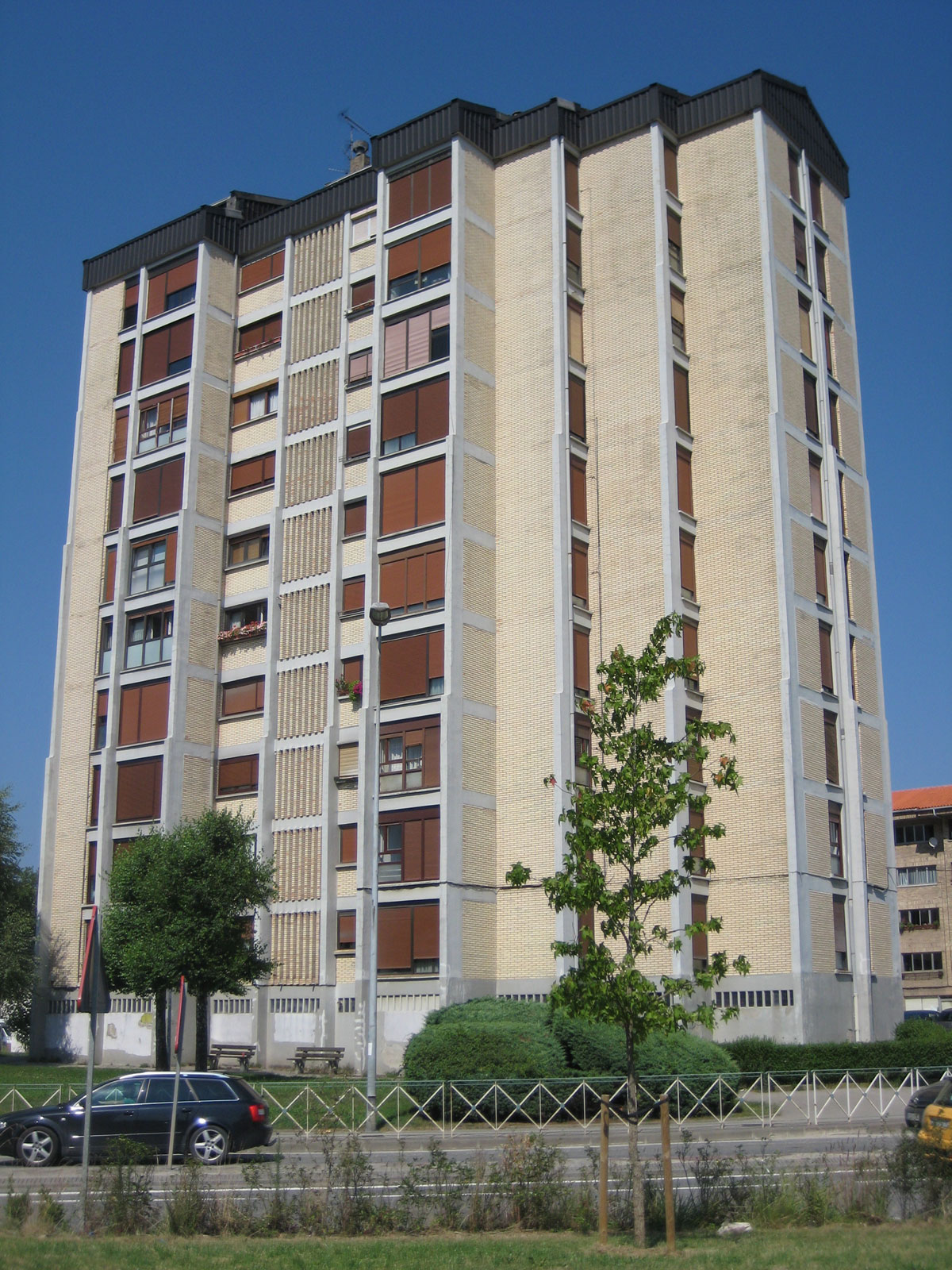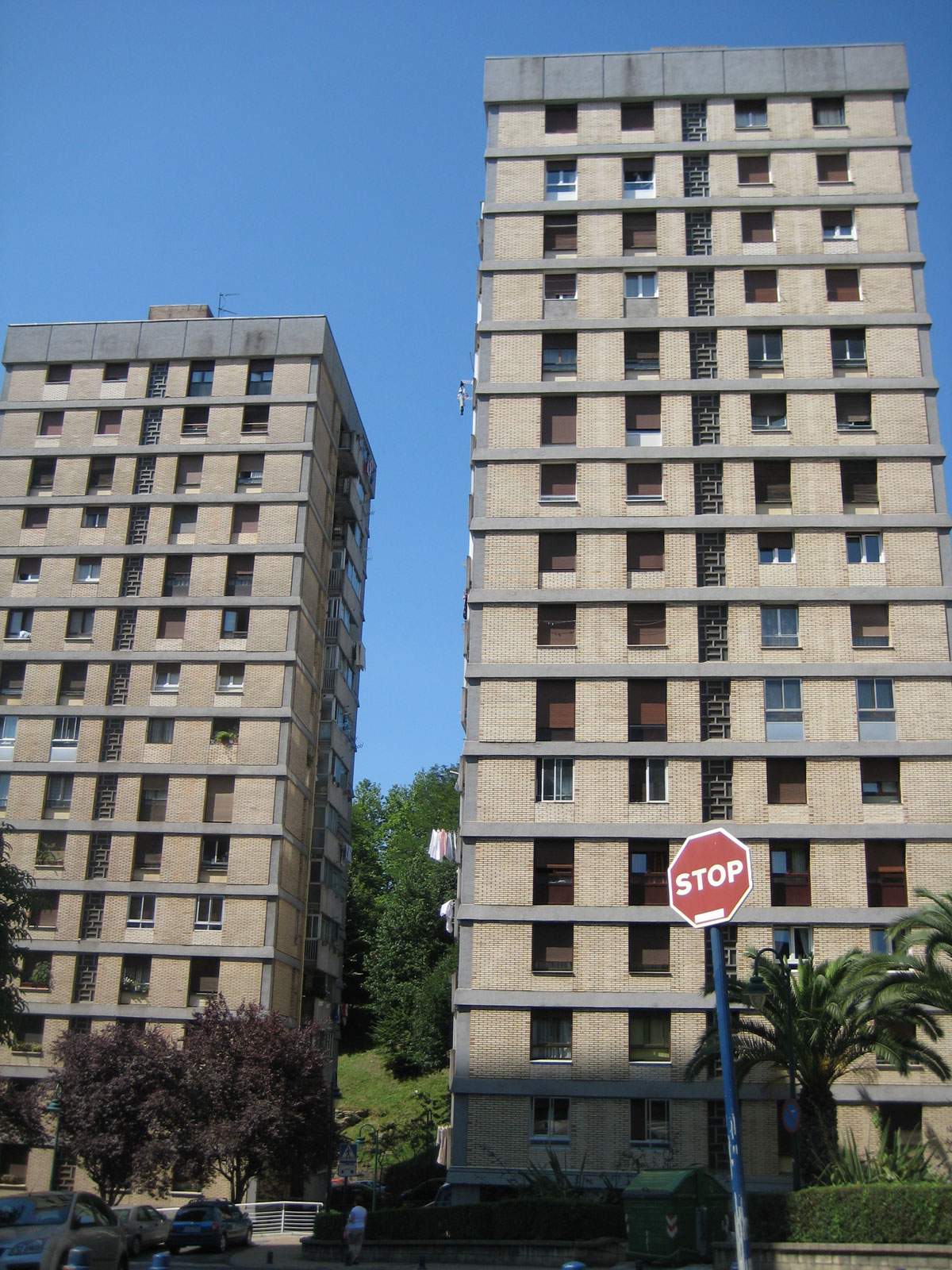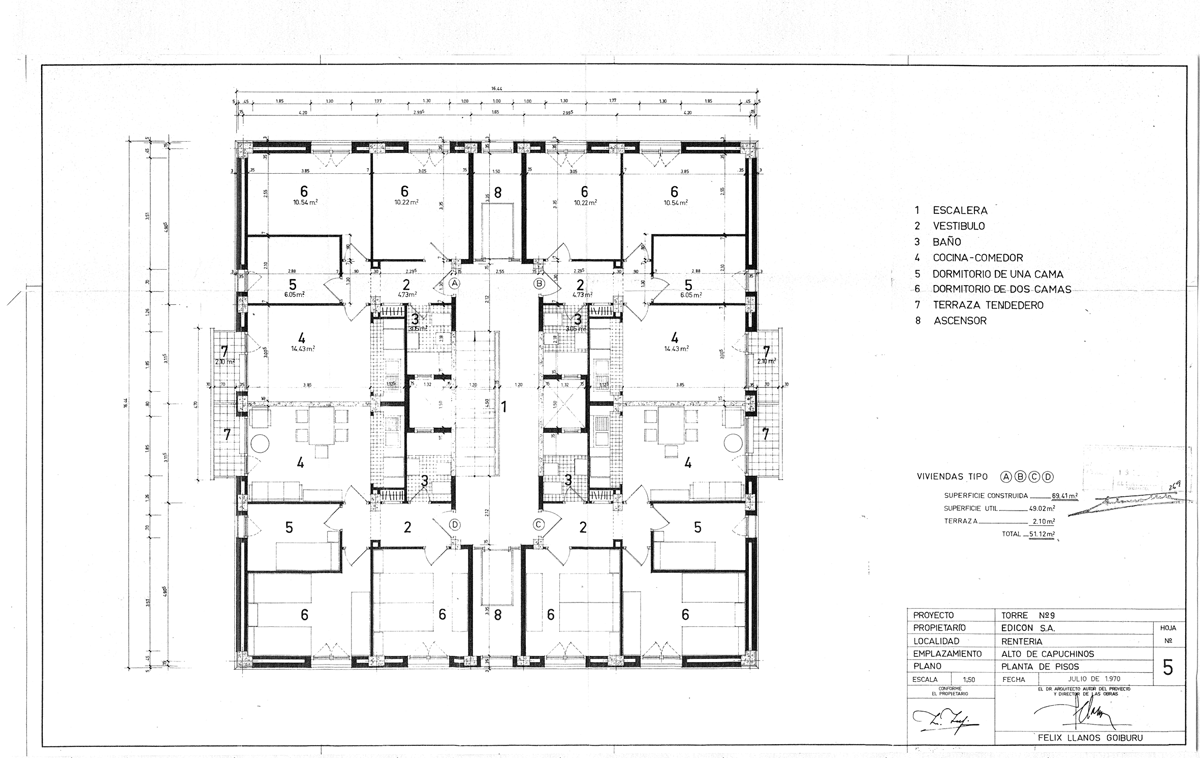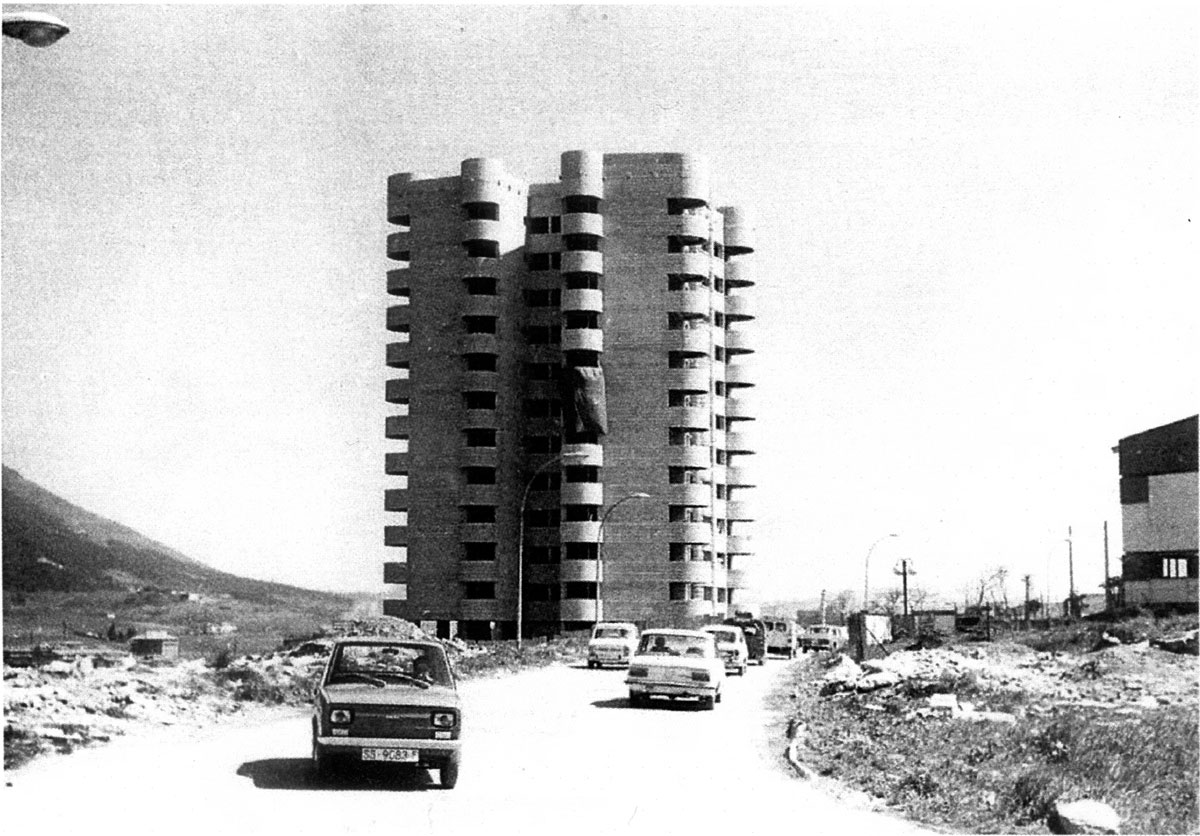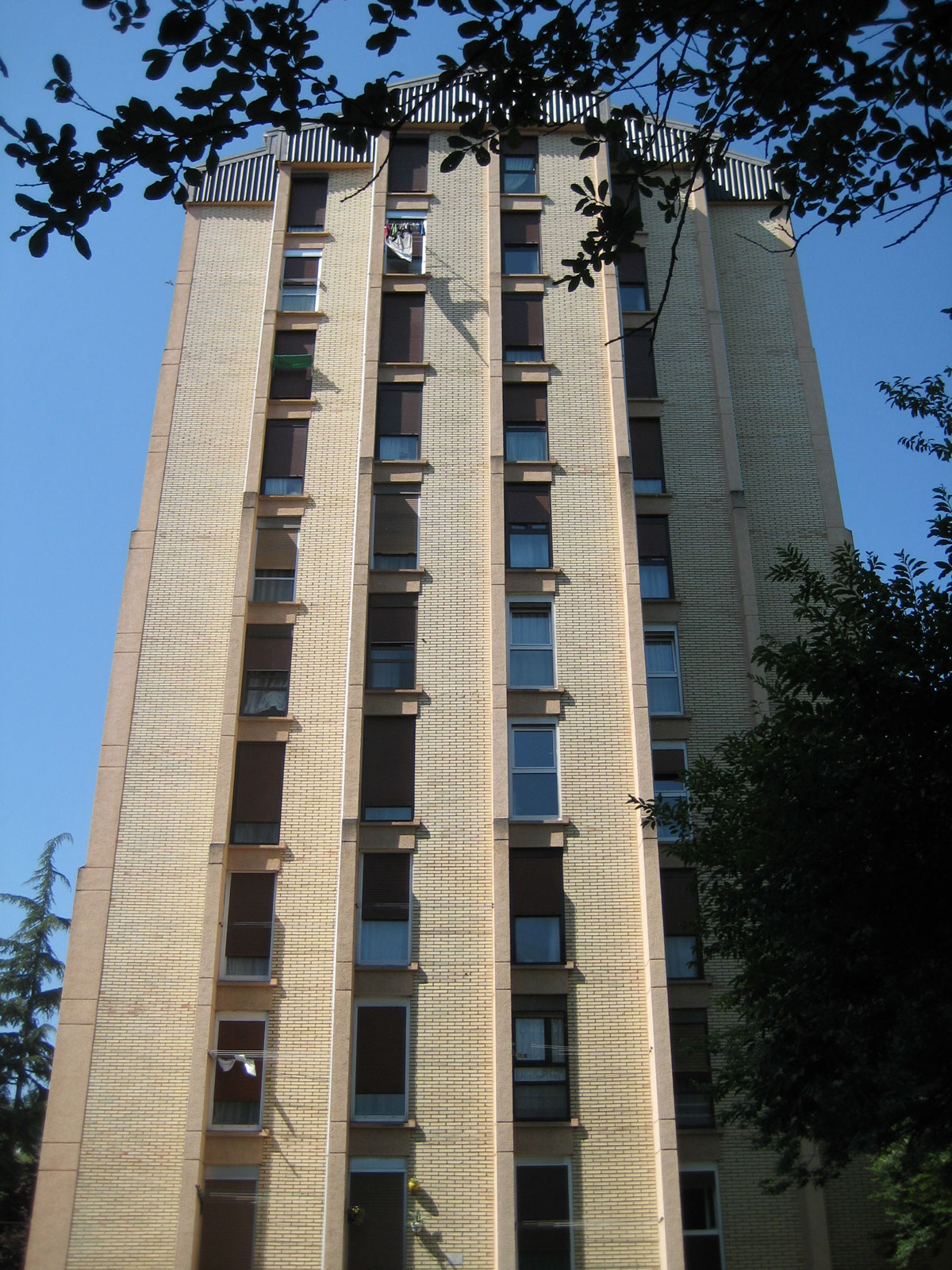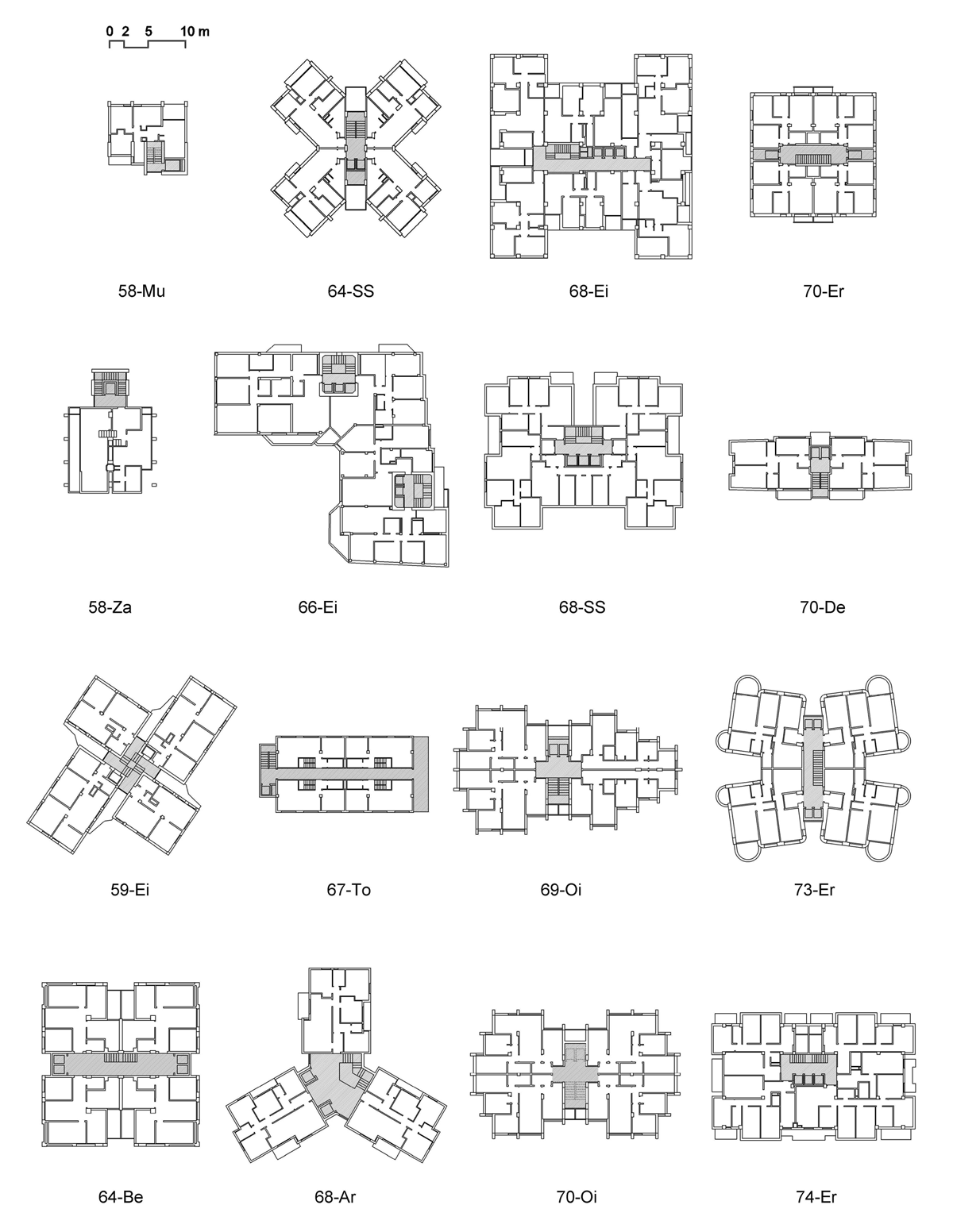Introduction
When it comes to reflecting the character of a place, architecture is a vital witness. Its testimony is especially enlightening in the case of buildings that are the result of creating a certain architectural type for the first time since the end result not only responds to the will of the local architects and the adoption of canonical models but also to the particular circumstances of place, whether technological, social or cultural. This can be demonstrated by studying the high-rise residential block, which is the most faithful testimony of the period of development in Europe during the middle decades of the 20th century. As far as the place is concerned, let us consider how this residential type was implemented in the province of Gipuzkoa, a significant part of the Basque Country, whose capital is San Sebastián and which borders France (Fig. 1), in which the tower block was employed more than in the rest of the provinces. Before addressing the subject, let us briefly explain the background to this high-rise building cycle which took place between 1958 and 1973.
After the end of the Spanish Civil War (1936–39), the dictatorship of General Francisco Franco, following the model typical of the totalitarian regimes and, due to the international isolation of Spain in the post-war era, initiated a period of economic self-sufficiency in order to maintain hypothetical political independence from foreign countries. In this autarchic era, which began in 1939 and ended in the late 1950s, no high-rises were constructed. At the end of this period, thanks to national plans launched by the Instituto Nacional de la Vivienda (INV; National Housing Institute), a number of new high-density neighbourhoods were built in response to the large population growth in cities and industrialised regions. Among the latter was the Basque Country where, in the 1960s, as a consequence of immigration from other parts of Spain, as well as natural growth, the population increased greatly. Before 1950, the average growth rate was 15 per cent per decade; this increased by 27% between 1950 and 1960 and by 32% over the following decade, reaching 630,000 inhabitants by the end of 1970 (Galdós 1991).
Responding to the urgent need for new housing, the new residential type was first implemented in 1958, and then used for about 15 years, until the first oil crisis in 1973. The term ‘tower’ as applied to these buildings refers less to their height than to their proportions — the ratio between their height and floor plan dimensions. However modest they are relative to their contemporaries elsewhere, their analysis proves the local reproduction of a phenomenon that occurred all over the capitalist world, which was a consequence of the correlation between economic cycles and the evolution of building types: when the residential housing type began to grow in height and take the form of increasingly slender models, the crisis which led to the end of the economic cycle became apparent (Thornton 2004). From the mid-1970s onwards, during a period of economic crisis and political regime change, the demographic evolution in the Basque territories went into decline. As a consequence, housing production, which was subsequently implemented by the Basque Government until the late 1980s,1 adopted medium-rise residential typologies, in response to the stabilisation of demographic statistics (Rodríguez Marcos 2001).
Today, half a century after the end of this high-rise building cycle, various studies can be found about the construction systems used in Spain in residential building in the 1960s, such as Arquitectura sin fisuras, by Adell Argilés (2000), and books containing in-depth studies of the building envelope in 20th-century housing (Domínguez et al. 2016). There are even papers dedicated specifically to the construction of façades during the developmental period in Gipuzkoa (Lizundia 2015). However, as far as typological analysis is concerned, the first tower blocks have not been the subject of specific studies, although some Spanish cases have been addressed in books with worldwide readership, such as Floor Plan Manual: Housing (Heckmann and Schneider 2017). The present paper proposes a new insight on the architecture and design of housing. Unlike other studies that have been carried out from particular perspectives, it relates the construction of the first residential towers as a whole to their typological solution, and the influences under which they were carried out. The advanced typological solutions based on contemporary projects in Western countries reveal that the technological solutions in Spain were conservative, the result of the isolationist period experienced by the country after the Spanish Civil War; the new architectural type was not built with new construction systems. Nevertheless, the solutions adopted, in which composition and construction are inseparable, became an experimental and creative field for the architects of the 1960s, especially evident in the first residential tower blocks that were built in Gipuzkoa.
In the first part of this paper, after reviewing the social context of the time and the urban management tools that made possible the birth of the new residential type, I will examine the specific characteristics of the construction systems. The second part is devoted to a presentation of 16 case studies from which the common features have been extracted. I begin by setting out the regulatory framework in which the first towers of Gipuzkoa were designed and built.
The New Mid-Century Urban Management Tools
By the mid-20th century, urban management in Spain was provided with new administrative tools that would be more effective for the development of urban planning. In the province of Gipuzkoa, the Territorial Plan of 1944 resulted from the collaboration between the Diputación de Guipúzcoa2 (DG; Provincial Council) and the governmental Dirección General de Arquitectura (General Directorate of Architecture). At the local level, the general plans of various municipalities were approved, such as those of Tolosa (1954), Rentería (1955), and Eibar (1959). Great growth was expected in all of them, as a consequence of which the population would double within a few decades. At the State level, the first National Housing Plan was launched in 1955 with the aim of building 550,000 flats under the Limited Rent Housing Law (1954). In 1959 the government approved the Development Plan (1964–67), whose objective was to maximise the growth rate of GDP.
Even more decisive than the above plans was the entry into force of the 1956 Land Law (Ley de 12 de Mayo de 1956 sobre Régimen del Suelo y Ordenación), which implemented an inclusive analysis of the territory by means of a number of different plans, from a national plan of urbanism to provincial plans and municipal plans (Candela 1994: 39–68). As Trevor Goldsmith notes, despite being enacted by a right-wing authoritarian regime, the law turned out to be surprisingly progressive in its purpose, which included not only the careful regulation of property rights but also the promotion of the interests of the community (2011: 332–334). Unlike pre-war planning laws, which did not categorise land use according to its function, the law advocated ‘organic planning’ as a way to implement the functional zoning method. Notwithstanding this, the most effective of the new tools provided by the law, given its power to convert rural land into urban land, was the polígono, a housing scheme whose creation was the first step towards the building of future neighbourhoods. Once the local government had selected rural plots scattered in the periphery of the municipality, it could add to them, thus forming a development area of irregular shape, hence its name, upon which future development would be carried out. The development of each polígono corresponded to guidelines developed in what was called the Partial Plan. Once approved by the provincial council, this plan for each polígono defined the alignments, heights, volume and use; matters relating to the facilities and roads; and, last but not least, the building coefficient which determined how many cubic metres could be built per square metre of urban land (Vinuesa and Vidal 1991). The Partial Plans allowed architects to test, for the first time, an open residential order, in contrast with the 19th-century constructions between party walls. This is how the idea of a neighbourhood unit grouped around basic services took shape, as happened with the units designed by Clarence Perry in the late 1920s (Rubert de Ventós 2009). In 1959 the Comisión Provincial de Arquitectura y Urbanismo (Provincial Office for Architecture and Urbanism) published their longterm plan for the locations and characteristics of 24 polígonos in Plan de Preparación de Suelo en la Provincia de Guipúzcoa (Land Preparation Plan for the territory of Guipúzcoa).3 Because of the high building coefficients that the Partial Plans had established to accommodate the growing population, building neighbourhoods composed of a group of slender towers would become the most successful solution.
Territory and Typology, Light and Shade
The relationship of these residential groups with their urban environment has, at times, been problematic. Until 1960, the urbanisation of the industrial and rural towns of Gipuzkoa took the form of successive transformations according to the gradual evolution of the needs of those areas (Unzurrunzaga 1993: 55–71). Despite the strong urban expansion in the periphery of the historic centres after the implantation of industrial sectors in the late 19th century, the territory maintained its spatial and structural balance until the 1950s. However, in the late 1960s the gradual growth of these cities changed, and growth accelerated dramatically. The urban structure of these towns, basically that of a historic town, became that of a town with a historic centre, the only part with spatial interest, and new groups of tower blocks gravitating outward. This building fever seemed to exist only because of the desire to achieve economic growth by appropriating the symbols of the city (Vinuesa and Vidal 1991: 19). There was such a strong identification between city and development in that society, which was eager to achieve the path towards growth, that towers appeared everywhere, even in rural areas, where neither the way of life nor any other socio-economic reason justified them.
However, regardless of their troubling relationship with urban environment, these tower blocks were pioneering experiments. With their new internal logic, not only stood for progress but also enhanced the conditions of modern urban life, in contrast to the pre-existing city (Cambi, Gobbi, and Steiner 1981: 10–14). These experiments were made in times when knowledge of international architecture was somewhat limited and young architects were fascinated by the new tower type to which the mission of announcing the arrival of the future was entrusted. According to the Spanish architect Rafael Moneo,
When a new type emerges, and when a group of architects are able to describe a new set of formal relations that generates a new group of buildings, then those architects’ contribution has reached the level of generality and anonymity that characterizes architecture as a discipline. (1978: 28)
Indeed, by the end of the 20th century, the architecture of the 1960s, and particularly multi-storey residential buildings, would be considered as unexciting, anonymous and lacking a past. Nevertheless, all the case studies reviewed in this paper were actually the result of an open-minded attitude, as befits an initial exploration. While they all adopt the tower block type, each uses a different model of floor plan. These projects are intimately linked to the concept of typology, a concept that has alternated between a central and a marginal position in the history of architecture. Handbooks, which were so important for the architects of the Enlightenment in the 18th century and presented the various models that could be obtained from a certain type, began to lose popularity when the modern theoreticians of the 1930s rejected the idea of typology, claiming that it restricted the architect’s creativity. According to Walter Gropius (1955: 66–70), it was possible to undertake the process of design without reference to prior examples. Nevertheless, 30 years later, facing the challenge of mass housing, repeatability was desirable and consonant with industrial processes. The floor plans of the case studies are proof of this.
The Technological Gap and the Development of a Unique Façade Solution
In Spain, the load-bearing structure of residential buildings was made of reinforced concrete, a material that had been standardised after the war ended in 1939, following the government’s publication of Instrucción para el Proyecto y Ejecución de Obras de Hormigón (Instruction for the Design and Execution of Concrete Works). During the autarchic period of the Franco government, its policy was to minimise the import of construction materials, opting instead for reinforced concrete, which was less dependent on steel than structures made entirely of rolled steel sections. It was an obvious choice in the province of Gipuzkoa, for two reasons. First, cement was readily available locally, from Cementos Rezola, the main cement manufacturer in Spain, based in San Sebastián, the capital of Gipuzkoa. The second reason was the proximity of France, the leading country with regards to concrete technology, with which Gipuzkoa shares a border. As we shall see later, an exception is the towers of Bidebieta (64-SS),4 which despite being initially designed with a reinforced-concrete frame were finally erected with a steel frame following the decision of the INV.
These load-bearing reinforced-concrete frames were enveloped by brick walls (Fig. 2), a consequence of a characteristic mutation that affected façade technology throughout Spain and was not replicated in other European countries. In Europe, until the end of the 19th century, brick construction had been based on the structural character of walls and their solid homogeneous composition (Plumridge and Meulenkamp 2000). Meanwhile, in Britain, the cavity wall system was developing. For the first time, the brick façade was separated into two walls, with the load-bearing slabs resting on the inner wall and the exterior skin forming a cavity which served as a barrier against moisture. This solution spread across many European countries as the 20th century progressed. But in Spain, builders chose to use a solid exterior load-bearing brick wall which, from the middle of the century, would be paired with an inner brick wall to form a cavity serving as a moisture barrier.
During the post-war reconstruction in Europe, each country adopted a particular construction technology which reflected the different degrees of industrialisation involved. The prefabricated industry gained the greatest momentum in France (del Águila 1986: 97). During the reconstruction period, a major overhaul, led by the Ministère de la Reconstruction et de l’Urbanism (MRU), drove the transformation of the construction industry by encouraging the study of new ways of building (Bullock 2007). In the mid-1950s, as a clear result of this policy, at least 144 systems of prefabrication for walls and building enclosures were patented, including the Camus System, Panobloc elements and Mopin panels. If we include the former USSR among the industrialised countries, we find that precast concrete panels were first introduced in the late 1950s using cheap and fast experimental construction to solve a severe housing crisis. The K-7 panel series, developed by the architect Vitaly Lagutenko, went into mass prefabrication and construction (Malaia 2020), replacing brick, which had been the traditional material in Russia (Wright 1970: 24–26). Furthermore, within the Eastern Bloc countries, a variety of large-panel systems were used, such as P2 and M10, the latter of which was the most commonly used in the German Democratic Republic until the 1970s (Pugh 2008: 134).
The industrialisation of construction was, however, delayed in other European countries. In the UK in the 1960s and 1970s, exposed concrete became increasingly popular (Addis 2003). Until the mid-1960s, the construction of the façades of multi-storey residential towers in the UK had relied on in-situ concrete. The variety of architectural cladding then increased, and towers began to be clad with essentially precast concrete panels attached to a concrete or steel frame, imported from France and Scandinavia (Finnimore 1989). Housing programmes grew considerably, and investors became more confident in local authorities and the government’s commitment to system building. Both foreign and UK building systems began to flood the market. Since the number of systems was far beyond the housing capacity, it soon became obvious that only some of these systems would become successful. Such was the case for the Reema Hollow Panel, Wates, Bison’s Wallframe and Wimpey No-Fines (Diamant 1964).
By 1951, West Germany was building 87 dwellings per 10,000 inhabitants, and between 1950 and 1959, 5.2 million new units were completed, compared with 2 million in France. With these early successes, public expenditure could be steadily reduced. These output and tenure shifts were supported by tax incentives awarded to private-enterprise construction. Such shifts were also eased by policies specific to the house-building industry, emphasising not French-style factory prefabrication but a lower-profile rationalisation of building components and site organisation, as in Switzerland and Holland (Glendinning 2021: 223–224).
In Italy, L’Istituto Nazionale delle Assicurazioni (INA; National Institute for Insurance) funded the INA-Casa plan (1949–63). Its first aim was to build rental housing for workers, which could subsequently be converted to home-ownership status. The INA-Casa plan also aimed to boost employment in the building industry as both an economic flywheel and a check on social unrest (Glendinning 2021: 272). The plan encouraged change in a direction opposite to that of innovation and, in particular, prefabrication. It thus imposed a way of building houses with low mechanisation and high employment in the labour force (Poretti 2010: 114).
In Spain, industrialised cladding was not fully transferred into the construction industry. The external envelope continued as a double brick wall, composed of an interior skin and an outer, load-bearing skin. This solution persisted even in the second half of the century, after the traditional relationship between slabs and façade was reversed, by building the façade on the edges of slabs, rather than supporting the slabs on masonry walls (Adell Argilés 2000: 24–25). Consequently, massive brickwork would eventually be replaced by a double hollow brick wall, a solution that was quickly adopted by all construction agents. It came to be referred to as a ‘conventional façade’ or a ‘traditional façade’, even though it did not respond to any tradition.
However, despite the rudimentary nature of this system, or perhaps because of it, the brick façade became an invitation to experiment, particularly with the appearance of the exposed brick, and especially in the construction of residential towers. Their free layout and unavoidable urban presence, as well as the unifying nature of their envelope, unrelated to concepts such as main façade, rear elevation or inner courtyard, made the construction of their façades respond to an integral concept systematically applied to its entirety. Furthermore, as in the high-rise residential buildings of the Italian INA-Casa plan, the reinforced-concrete structure appeared on the façade to form a grid, the antithesis of the dematerialisation of the wall of the International Style building (Poretti 2010: 120). In this way the relationship between the brick walls and the exposed structural elements would become the object of an elaborate composition which aimed to compensate for the lack of new industrial systems: concrete screens, columns and slab edges would be shamelessly put on display to accentuate the power of a structure whose task, as a tower, was more prominent than in the past. Finally, although the perforation of the building envelope with structural elements had serious adverse effects on the thermal properties of the envelope, this problem was treated with indifference by the architects and the building sector as a whole, largely because standards regarding the thermal performance of buildings were still pending.5
An analysis of the case studies shows that building envelopes underwent significant evolution during the period of this building cycle, from 1958 to 1973. Until the mid-1960s, the exterior finish of the envelope consisted of a continuous coating (see cases 58-Mu, 59-Ei, 64-SS, and 67-To) or a tiled finish (58-Za). The envelope was a wall of double hollow brickwork, with an air cavity in a simple hollow brick wall inside, rendered and painted. Thereafter, however, exposed brickwork appeared in building envelopes. The exposed brickwork, which was provided by Spanish companies from Albacete, Palencia and Jaén, succeeded because of its natural origin, the low level of industrialisation involved in its construction, and its suitability to being visible, adding to the building’s value. Moreover, the longer time required to lay the exposed brick, compared to the laying of ordinary brickwork, was compensated for by the shorter times during which scaffolding and auxiliary systems had to be maintained, since the exposed brick did not require plastering.
Aside from construction-related issues, the appearance of the exposed brick also responded to a cultural and even ideological impulse of the Basque architects of the 1960s that emerged from the influence of the Italian rationalist movement called Tendenza. This movement was formed on the cusp of transformations in Italy’s post-war economy, where in la nuova dimensione of the early 1960s architects and planners had sought to confront contemporary economic realities from within (Peckham 2007). The movement was opposed to the other neo-rationalist trend that was based on the almost exclusive use of white, which was so characteristic in the works of Peter Eisenman, Michael Graves, Charles Gwathmey, John Hejduk and Richard Meier, who became known following the 1969 exhibition at MoMA in New York, on the occasion of the Conference of Architects for the Study of the Environment (Gössel and Leuthäuser 2001). In contrast to the works of these architects, also called The New York Five, Italian architects such as Giorgio Grassi and Aldo Rossi professed the need to combine the rationalist thought of modernity with historical architectural typologies (Bozal 1996: 384). At the end of the 1960s, books such as L’architettura della città, by Rossi (1966), and Teoria e storia dell’architettura, by Grassi (1967), translated into Spanish by the publishing house of Barcelona Gustavo Gili, became highly influential (Ruiz Cabrero 1989: 58). These essays were aimed at resetting the characteristics of architecture for a contemporary city which does not see its future through the myths of high technology and standardisation (Acocella 1984: 18). These ideas were echoed by the Basque architects. At the beginning of the 1970s, the office of the Colegio Oficial de Arquitectos Vasco-Navarro (Official Basque Architects’ Association) in San Sebastián organised a series of lectures on architecture, inviting some of the most representative architects of the Tendenza movement, such as Rossi himself, Carlo Aymonino and Manfredo Tafuri. The influence of these lectures is evident in the case studies that were built in the early 1970s, not in their residential type but rather in the materiality of their construction. With the help of the influential Oriol Bohigas, who advocated for the authentic process of construction (Bohigas 1962), the Italians advocated the use of the natural colour of uncoated materials, such as marble, concrete or brick6. Nevertheless, sincerity went beyond tangible materials. Indeed, the Italians claimed even the contribution of shadow, a non-material resource that emphasised the order of the façade and the presence of structural elements. According to them, as a result of this strategy, the work would acquire a monumental aspect and be integrated into the urban fabric. The construction solutions used in these envelopes thus incorporated compositional and ideological arguments that should not be underestimated.
Ingenuity versus Conservatism: Classification According to Façade Solutions
This section presents a number of high-rise blocks built in Gipuzkoa that exemplify the concepts discussed above. This will include the context in which they were promoted and their typological solutions, identifying contemporary projects in France, Italy or England under whose influence they were carried out. The cases will be presented in chronological order, since it is in this way that the evolution of construction techniques in the envelopes of these buildings is best understood.
The first residential tower of the entire territory was designed in 1958, in the resort town of Zarautz. This is the tower of Vista Alegre, by Luis Peña and Juan Manuel Encío (58-Za), a private development carried out by a local builder. Such builders were men with experience in the construction trades who, during the post-war period, acquired rural land that would later become developable. They knew the municipal leaders and thus had considerable influence. The operations carried out by these men generally had no other purpose than making profit. The Partial Plan of Vista Alegre programmed the transformation of a large private park of 10 hectares that was located on a promontory at the edge of the sea (Fig. 3). The initial aim of the low building coefficient of 0.66 cubic metres per square metre was the extensive use of the plot by means of a number of small detached villas (AMZ D2106520). However, intending to reserve the largest green space and follow the precepts of the Charter of Athens (Mumford 1992: 155–156), the architects concentrated all residential use into eight slender towers at the perimeter of the park, accessed by a road that follows the contours of the hill (Fig. 4). The towers, the plan suggests, were intended to be identical, although only one was built. The plans for the remaining tower show that each apartment is 118 square metres over three floors, like the triplex dwellings designed by Gropius in the 1930s. On the middle floor, from which the apartment is accessed, the kitchen and services are located; the bedrooms are on the upper floor, and the living area is on the lower floor (Fig. 5). To equalise the sunlight, since each apartment has façades on opposite orientations, the floor plan was arranged according to the heliothermal axis which divides the arc of solar orientations into two balanced halves in terms of temperature and light. However, the project failed after the first tower was built.
The second residential tower was built in 1958 in the small fishing town of Mutriku (58-Mu) to accommodate families who had lost their homes in a fire (Fig. 6). It was designed by the same architects, Peña and Encío, and exemplifies projects driven by the local government institutions and carried out either via polígonos and Partial Plans or through direct development. They were minor developments, scarcely equipped for the requirements of living in small- to medium-sized municipalities. A board, formed by the local government and the union delegations, entrusted the Mutriku project to Encío and Peña, who, instead of rebuilding the two blocks destroyed by fire, proposed a single block of three heights, in line with the adjacent built environment, and a slender 13-storey tower, with a small square between them. The tower, which stands proudly over the houses of the fishing harbour, has one dwelling per floor and an asymmetrical organisation inspired by the apartments that occupy each of the arms of Hugh’s Tower in Harlow, Great Britain, designed by Frederick Gibberd in 1954. The structure was raised by concrete screens that wrap around the building, giving great rigidity to the structure. To the same field of municipal promotion belong the four towers of Armería (59-Ei) in Eibar, an industrial village that experienced great growth in the 1950s. They were designed by Hermenegildo Bracons in 1959 and comprised 120 dwellings (Fig. 7). A central staircase of four sections gives access to the apartments in the form of four arms revolving around it (AME 6896.01). The layout shows an evident influence of the towers of Bobigny in Paris that were designed in the mid-1950s by Georges Candilis, Alexis Josic and Shadrach Woods (Klein 2014).
Apart from the municipal level, there were also public projects by the Spanish government. Despite being less frequent, they were characterised by the magnitude of the operation and by being driven by participants of higher rank: the INV as a developer and the Obra Sindical del Hogar y de Arquitectura (OSHA; Union Work of Home and Architecture) as the executive arm (Etxepare 2011). To this group belongs the Polígono Bidebieta in San Sebastian (64-SS), a public housing estate on 17.5 hectares, whose first formal interventions date to 1961, when the INV initiated the Expropriation Project for some rustic plots and their integration into a polígono. The site was then developed through a Partial Plan which stipulated a building coefficient of three cubic metres per square metre. The project comprised 12 towers, arranged freely within a garden and joined by means of a road (Fig. 8). The influence of the urban principles of Le Corbusier is clear. Each tower, with a standard blade-shaped floor plan and a staircase on its axis, has 15 floors and four apartments per floor, for a total project of 732 dwellings (Figs. 910). They were built from 1964 onwards and designed by Luis Alústiza, who was inspired by the towers of Stuyvesant Town in New York (Plunz 2016: 255–260). This polígono was conceived as a new town, equipped with the necessary services to guarantee its autonomy given the estimated 3,700 inhabitants. Unlike residential units promoted by local governments, INV projects were distinguished by an ambitious set of facilities suitable for the large number of families which the new town was to receive. According to the project, which is in the General Archive of the Basque Public Administration (AGAPE SS-501-4507), the Partial Plan included a nursery and a primary school, a section of the city’s Secondary Education Institute, a social centre with premises for associations and neighbourhood assemblies, health services with a medical clinic and two pharmacies, a commercial centre, a parish church and a civic administrative service.
Among the agents outside public institutions was a type of developer that does not correspond to the private profile mentioned in the first case study: the cooperative society, driven not so much by any financial benefit but rather by the will to launch new community projects. The Basque cooperatives, born at the end of the 19th century, focused their activity on services, not only because of the need for lower levels of investment but also because existing trade dealings were often unfair (see Williams 2007). The cooperatives emerged with a local perspective, motivated by people who discovered the possibility of meeting needs through self-organisation. Modern cooperativism emerged side by side with mid-century industrialisation, with ideological influences, and aspired to create a new socio-economic system in opposition to the established order. One of the activities of the cooperatives was housing construction, although these projects went beyond purely residential projects. The Polígono 58 in Tolosa, developed by the Cooperativa San Juan Bautista (67-To) in 1967, is a case in point. On a plot of 9,000 square metres, and with a building coefficient of 3 cubic metres per square metre, the architect Armando Roca proposed a set of five towers that were highly innovative from both a typological and a programmatical perspective, influenced by Le Corbusier’s Unité d‘habitation in Marseille of 1945. Roca conceived a tower with a staircase attached at one end and an interior street providing access to the four duplex apartments leading into a communal terrace on every second floor (Figs. 111213). It shares some similarities with the tower by Georges Candilis in the neighbourhood of Blanc Mesnil (1955), where a central street gives access to four apartments. The explanatory report for the project, which can be found in the Municipal Archive of Tolosa, occasionally adopts the language of a manifesto, reflecting the ambition underlying this community project:
The man who lives in this place will become an intelligent man of great honesty, freed from all consumerist impulse since he will feel enriched by the shared properties. In these times when you want to cancel out the desire to learn from people, an environment of work, study and community life will fill these buildings. In this new vital environment, neighbours will feel like guardians of a new order. (AMT B537/1967/0015)
The façades of the above cases were built using the most successful solution in mid-century Spain: an outer skin of hollow brickwork, rendered and painted, an air cavity and an internal skin of hollow brick, plastered with gypsum. The structure is hidden in all cases, enclosed as a continuous wall, usually painted in light tones. From this time onwards, brickwork was visible and the envelope of these blocks acquired a characteristic materiality. The tower of Polígono Zabalotegi in Bergara (64-Be) of 1964 was the first example (AMB 02 C/3022-001). It is an imposing tower with a square plan that refers back to the square blocks by Adalberto Libera and Vittorio Cafiero in the Olympic Village of Rome of 1957. In its façade, the exposed brickwork, laid in stretcher bond pattern, is confined between columns and slab edges in exposed concrete.
Within the Unzaga square in the municipality of Eibar was built the Unzaga tower (66-Ei), for many years the tallest tower in the Basque Country. Designed in 1966 by Ander Basterretxea, it has 18 floors and an L-shaped floor plan, housing a cinema and offices as well as 44 residential units (AME 6935.05) (Figs. 1415). It is clad entirely in exposed brickwork, like the Kurtze Txipi tower (68-Ar) of 1968 by Luis Astiazarán in the industrial town of Arrasate. The plan of the Kurtze Txipi tower is obviously influenced by the towers of the Cité de l’Abreuvoir by Émile Aillaud and Jean Vedrès (1954), articulated in the form of three arms, each containing a single dwelling (Figs. 1617). From the same year are the two towers on a plot adjacent to Polígono Bidebieta, by Luis Astiazarán (AMSS A-01476-01). They have a symmetrical floor plan with four apartments per floor (68-SS). The envelope in exposed brickwork is divided by and aligned with the slab edges which are covered with a stone plate. Also in 1968, the four Urkizu towers, designed by Javier Peñalba, Carlos Sobrini, and Joaquín Domínguez (68-Ei), were built in a polígono of 13,400 square metres (AME 6954.02). The high building coefficient of 7 cubic metres per square metre assigned by the Partial Plan is a sign of the great pressure for housing in a town with a scarcity of land and a population in continuous growth (Fig. 18). The Urkizu towers are massive blocks whose standard floor plan, with six apartments, is 610 square metres. Although they take the form of an H in the plan, the interior organisation of the apartments is not symmetrical. In their exposed brick façades, the slab edges are shown around the perimeter of the brickwork.
In 1969, because the Rentería-Oyarzun Partial Plan did not materialise, the Gerencia de Urbanismo de Guipúzcoa (Planning Directorate of Guipúzcoa) left the development of a part of the land in the hands of one of the owners (Fig. 19). The Polígono Rentería-Oyarzun, which is closer to the centre of the neighbouring municipality than to the centre of its own town, is a clear example of these polígonos that gravitate towards the urban periphery (AMO 2536). Three 10-storey towers were built by José Javier Uranga, with a façade of earth-coloured, exposed brickwork. One of the towers adopts a symmetrical plan (70-Oi), while the other two (69-Oi) adopt a pointed shape with multiple folds to obtain adequate sunlight in all the rooms (Fig. 20). In 1970, Félix Llanos designed Polígono Capuchinos in Errenteria, an industrial town close to San Sebastian (AMEr AAC417E1). Its Partial Plan is made up of nine square towers (70-Er), 16.5 by 16.5 metres and 44 metres in height, comprising four apartments per floor (Figs. 2122). In their façade, as with the 64-Be case, exposed brickwork in a stretcher bond pattern is bounded by columns and slab edges in raw concrete. The relationship of the central staircase to the landing and the two adjacent courtyards refers back to the blocks by Adalberto Libera and Vittorio Cafiero in the Olympic Village in Rome of 1957 (Cannone, Sturiano, and Vesco 1980: 139). Three years later, next to the group of towers of the aforementioned Polígono Capuchinos, one tower (73-Er) was built, although the initial project had planned for the construction of four identical towers (AMEr AAC606E8). The standard floor plan comprises four apartments of 84 square metres arranged symmetrically around the stairs and landing (Figs. 2324). This layout recalls the design in 1964 of the four towers by Norman Dawbarn on Samuel Street, in Woolwich, UK. A final example is Polígono 28, also in Errenteria, made up of two imposing towers (74-Er) with five dwellings per storey and an asymmetric organisation within the rectangular floor plan (AMEr AAC528E2).
Tower blocks built since 1964 can be divided into four groups according to how the exposed brickwork and the visible structural elements were arranged. First, there is the stratified façade in which the line of the floor slabs is accentuated, such as case 68-Ei. Unlike façades of the 1950s, in which a floor could be indicated with a thickness that was no greater than that of its real edge, in the towers of the 1960s, the edge of the slab is provided with a suspended concrete skirt, with the aim of accentuating the stratification of the floors. In the second group are the façades in which the slab edges are hidden behind the exposed brickwork, the columns appearing in the form of exaggerated buttresses, thus emphasising the power of the vertical structure. This is seen in case 69-Oi, where the emphasised columns run vertically along the entire façade, causing deep shadow lines (Fig. 25). In the third group is the confined brickwork, in which the brick wall panels are framed in a grid of exposed columns and accentuated slab edges (70-Er). In all three, the exposed brickwork is usually built in a stretcher bond pattern that pays attention to the modulation of the façade and uses a metric brick 24 cm in length. Leaving aside the façades whose structural elements are completely covered (for example, 70-De), the final group consists of façades covered with thin brick tiles over curved concrete elements, such as railings and ledges (73-Er). All of these examples were solutions of a radical sincerity and demonstrate the inventiveness of the architects of the time who, having no access to prefabricated façade systems, made a virtue of necessity.
Conclusion
The cases described above form an eloquent local testimony of an era of great development. They were the product of a large growth forecast, which would be revealed in every one of the features that urbanism and architecture adopted at that time (Farhat 2010). Although some of the cases can be criticised in terms of their relation to site, as Maria Rubert de Ventós explains (2009), not all the polígonos based in dense housing solutions were the same. Some responded well to the site, others less so, depending on how well two determining conditions were met: the size of the development and the features of the boundaries of these housing schemes which conditioned their relationship with the built environment. Indeed, some of the new neighbourhoods were successfully inserted into urban centres and were provided with good road and pedestrian communication. Such is the case of Polígono Bidebieta (64-SS) and also the group of towers of San Juan Bautista (67-To) which, over the last few decades, has been fully integrated into the urban area of Tolosa.
From a typological perspective, these case studies show the inventiveness of the designers in the purely architectural concept of the buildings — that part of the project that can be achieved through drawing elevations, sections and, especially, floor plans. As can be seen in a presentation of all the standard floor plans from the case studies (Fig. 26), the resolution of the floor plan is a plural ensemble which includes compact, arm-shaped or asymmetrical floor plans. Indeed, these floor plans reflect in-depth research about the residential tower type, inspired by the floor-plan manuals published in Europe and the United States and based on parameters related to the needs of the inhabitant: space, sunlight and the correct relationship between the rooms (Heckmann 2017).
From a technological point of view, however, unlike in more industrialised countries where the construction of the mass housing was achieved by means of new factory-produced, road-transported and dry-mounted building systems, the high-rise residential block in Spain was born with an inherent contradiction. Although these buildings show a willingness to innovate on issues related to the organisation of the accommodation units and the streamlining of the building processes, their construction was not accompanied by any significant technological advances and did not make use of industrialised construcion processes. The early residential towers in the Basque Country did not fulfil the first of the characteristics of industrialised buildings as defined, for example, by Florian Urban: ‘There are two main characteristics of industrialized buildings as opposed to traditional site-built homes. First, they are assembled from prefabricated parts, and second, they are not constructed individually, but rather in series according to a rationalized process’ (2012: 8).
There were certainly some contemporary initiatives addressing industrialised building that deserve praise. For example, the International Competition for Housing Industrialisation, launched in 1949 by the Instituto Técnico de la Construcción y del Cemento (ITCC; Technical Institute of Construction and Cement) was inspired by the competition launched in 1945 by the Italian Consiglio Nazionale delle Ricerche (CNR; National Research Council) to encourage the use of prefabricated systems in the experimental district development built as part of the 8th Triennale in Milan (Cassinello 2017). In fact, the INV had tried in its early years to modernise public housing policy and through it, the private housing industry, by incorporating industrialisation into the construction field. However, in the end, as in Italy, it was the pragmatic vision of Luis Valero Bermejo, the director general of the INV, that prevailed. Valero was convinced that choosing solutions such as prefabrication would mean losing many jobs, which was politically unacceptable at the time. That is why the modernisation of housing in the Basque Country, especially of high-rise buildings, was limited to the rationalisation of the floor plan and the normalisation of only some of the construction elements (García Vázquez 2015). In such a conservative technological context, the architects of Gipuzkoa had to sharpen their wits and figure out ingenious solutions when faced with high-rise housing for the first time.
Notes
- Franco won the Spanish Civil War, so the Basque Government, which was created after the approval of the first Basque Statute of Autonomy in 1936, continued in exile. After the death of the dictator, this first Basque Government was formally disbanded after the approval of the current Statute of Autonomy (1979), and the creation of the new Basque Government (1980). [^]
- Note the different spelling with which the name of the territory is written. This is the Spanish spelling, which was the only official one, given that the Basque script (Gipuzkoa) and the language itself were banned during the dictatorship. The same applies to the municipalities: Rentería (Sp.) and Errenteria (B.), Oyarzun and Oiartzun, etc. [^]
- These urban extensions would be carried out by the Ministry of Housing, through the INV. Some consisted of low-rise linear buildings, while others incorporated high-rise buildings. The average area of these polígonos was about 70,000 square metres, and they had an average building coefficient of 2.3. The housing number was between 104 and 2,296. [^]
- The nomenclature used to refer to each case consists, within parentheses, of a number signifying the year in which it was designed followed by the two first letters of the municipality. [^]
- Insulating materials would not be incorporated into residential buildings until the entry into force of the NBE-CT 79 (Basic Standard of Building — Thermal Conditions of the Buildings, 1979) which set the requirements for insulation and thermal resistance of the exterior enclosure of a building to reduce its energy consumption. [^]
- The figure of Aldo Rossi became known in Spain because of the relationship established by Oriol Bohigas (from Barcelona) with the architects of Milan in the early 1960s. Bohigas promoted the creation of the School of Architecture of San Sebastián, University of the Basque Country in 1977, as a kind of branch of the Barcelona School of Architecture (ETSAB), which in 1982 became the first public school of architecture in the Basque Country. [^]
Competing Interests
The author has no competing interests to declare.
References
Unpublished Sources
AGAPE. Archivo General de la Administración Pública de Euskadi, Spain. SS-501-4507.
AMB. Archivo Municipal de Bergara. Bergara, Spain. 02 C/3022-001.
AME. Archivo Municipal de Eibar. Eibar, Spain. 6896.01, 6935.05, 6954.02.
AMEr. Archivo Municipal de Errenteria. Errenteria, Spain. AAC417E1, AAC606E8, AAC528E2.
AMT. Archivo Municipal de Tolosa. Tolosa, Spain. B537/1967/0015.
AMO. Archivo Municipal de Oiartzun. Oiartzun, Spain. 2536.
AMSS. Archivo Municipal de San Sebastián. San Sebastián, Spain. A-01476-01.
AMZ. Archivo Municipal de Zarautz. Zarautz, Spain. D2106520.
Published Sources
Acocella, A. 1984. Architettura italiana contemporanea. Gli anni ’70. Firenze: Alinea.
Adell Argilés, JM. 2000. Arquitectura sin fisuras. Madrid: Munilla-Lería.
Addis, B. 2003. Key Developments in the History of Concrete Construction and the Implications for Remediation and Repair. In: MacDonald, S (ed.), Building Pathology: Concrete, 15–105. Oxford: Blackwell Science. DOI: http://doi.org/10.1002/9780470773659.ch2
Bohigas, O. 1962. Cap a una arquitectura realista. Serra d’Or, 55: 17–20.
Bozal, V. 1996. Historia de las ideas estéticas y de las teorías artísticas contemporáneas. Madrid: Visor.
Bullock, N. 2007. You Assemble a Lorry, but You Build a House: Noisy-le-Sec and the French Debate on Industrialised Building 1944–49. Construction History Journal, 22: 75–95.
Cambi, E, Gobbi, G, and Steiner, G. 1981. Tipologie residenziali a torre. Milano: BeMa.
Candela, C. 1994. Soporte normativo del planeamiento urbanístico en España. In: Moya, L (ed.), La Práctica del Planeamiento Urbanístico. Madrid: Síntesis.
Cannone, F, Sturiano, A, and Vesco, MI. 1980. Città e abitazioni. Analisi dei rapporti tra la casa, i servizi e la forma della città moderna a Berlino, Parigi, Rotterdam, Milano e Roma. Palermo: Palumbo.
Cassinello, P. 2017. Eduardo Torroja: 1949 Strategy to Industrialise Housing in Post-World War II. Histories of Postwar Architecture, vol. 1. DOI: http://doi.org/10.6092/issn.2611-0075/6722
del Águila, A. 1986. Las tecnologías de la industrialización de los edificios de vivienda. Madrid: Colegio Oficial de Arquitectos de Madrid.
Diamant, RME. 1964. Industrialised Building — 50 International Methods. London: Iliffe Books.
Domínguez, S, Sendra, JJ and Oteiza, I. 2016. La envolvente térmica de la vivienda social. El caso de Sevilla, 1939 a 1979. Madrid: Instituto de Ciencias de la Construcción Eduardo Torroja.
Etxepare, L. 2011. Residential Architecture and Developmentalism: A Place and Two Contexts. In: Brebbia, C (ed.), Structural Studies, Repairs and Maintenance of Heritage Architecture XII, 247–257. Ashurst, Southampton: WIT Press. DOI: http://doi.org/10.2495/STR110211
Farhat, G. 2010. Au risque de l’anachronisme. In: Farhat, G (ed.), Les années soixante hic et nunc. Architecture, urbanisme, paysage, 7–10. Versailles: École nationale supérieure d’architecture de Versailles.
Finnimore, B. 1989. Houses from the Factory: System Building and the Welfare State 1942–1974. London: Rivers Oram Press.
Galdós, R. 1991. De la expansión al estancamiento: una panorámica de la evolución demográfica del País Vasco. Boletín de la Asociación de Geógrafos Españoles (13): 75–87.
García-Vázquez, C. 2015. La obsolescencia de las tipologías de vivienda de los polígonos residenciales construidos entre 1950 y 1976. Desajustes con la realidad sociocultural contemporánea. Informes de la Construcción, 67(EXTRA-1), m020. DOI: http://doi.org/10.3989/ic.14.045
Glendinning, M. 2021. Mass Housing. Modern Architecture and State Power. A Global History. London: Bloomsbury Visual Arts. DOI: http://doi.org/10.5040/9781474229302
Goldsmith, T. 2011. From Falangism to Technocracy: The Legislation and the Reality of Spanish Urbanism in Barcelona, 1939–1976. Journal of Urban History, 37(3):331–354. DOI: http://doi.org/10.1177/0096144211400318
Gössel, P, and Leuthäuser, G. 2001. Architecture in the Twentieth Century. Köln: Taschen.
Gropius, W. 1955. Scope of Total Architecture. New York: Collier Books.
Heckmann, O. 2017. A Graphic Approach to Floor Plan Design. In: Heckmann, O, and Schneider F (eds.), Floor Plan Manual: Housing, 54–58. Berlin, Boston: Birkhäuser. DOI: http://doi.org/10.1515/9783035611496-007
Heckmann, O, and Schneider F (eds.). 2017. Floor Plan Manual: Housing. Berlin, Boston: Birkhäuser. DOI: http://doi.org/10.1515/9783035611496
Klein, R. 2014. La Cité de l’Étoile à Bobigny. Candilis, Josic, Woods. Paris: Créaphis Éditions.
Ley de 12 de Mayo de 1956 sobre Régimen del Suelo y Ordenación Urbana. Madrid: Colegio Oficial de Arquitectos de Madrid, 1962.
Lizundia, I. 2015. La solución de fachada convencional del periodo desarrollista en el caso de Gipuzkoa: declive (y final) de un sistema constructivo. Informes De La Construcción, 67(538), e079. DOI: http://doi.org/10.3989/ic.13.167
Malaia, K. 2020. A Unit of Homemaking: The Prefabricated Panel and Domestic Architecture in the Late Soviet Union. Architectural Histories, 8(1): 12. DOI: http://doi.org/10.5334/ah.453
Moneo, R. 1978. On Typology. Oppositions. A Journal for Ideas and Criticism in Architecure, 13: 23–45.
Mumford, E. 1992. CIAM Urbanism After the Athens charter. Planning Perspectives, 7:4, 391–417, DOI: http://doi.org/10.1080/02665439208725757
Peckham, A. 2007. The Dichotomies of Rationalism in 20th-Century Italian Architecture. Architectural Design, 77(5): 10–15. DOI: http://doi.org/10.1002/ad.509
Plumridge, A, and Meulenkanp, W. 2000. Brickwork: Architecture and Design. London: Phoenix Illustrated.
Plunz, R. 2016. A History of Housing in New York City. 2nd ed. New York: Columbia University Press. DOI: http://doi.org/10.7312/plun17834
Poretti, S. 2010. Le tecniche edilizie: modelli per la ricostruzione. In: Di Biagi, P (ed.), La grande ricostruzione. Il piano Ina-Casa e l’Italia degli anni Cinquanta, 113–127. Roma: Donzelli.
Pugh, E. 2008. The Berlin Wall and the Urban Space and Experience of East and West Berlin 1961–1989. Unpublished thesis (PhD). The City University of New York.
Rodríguez Marcos, J. 2001. Estructura y cambios del parque residencial de la Comunidad Autónoma de Euskadi. San Sebastián: Eustat, Instituto Vasco de Estadística.
Rubert de Ventós, M. 2009. Polígonos sin alrededores. In: Archivo F.X.: la ciudad vacía: política, 538–556. Barcelona: Fundació Antoni Tàpies.
Ruiz Cabrero, G. 1989. Spagna. Architettura 1965–1988. Milano: Electa.
Thornton, M. 2004. Who Predicted the Bubble? Who Predicted the Crash?. The Independent Review (9): 5–30.
Unzurrunzaga, X. 1993. Proceso de Urbanización del territorio de Gipuzkoa. In: Planeamiento y Gestión Metropolitana Comarcal y Municipal, 55–71. Pamplona: Universidad de Navarra.
Urban, F. 2012. Tower and Slab: Histories of Global Mass Housing. New York: Routledge.
Vinuesa, J, and Vidal, MJ. 1991. Los procesos de Urbanización. Madrid: Síntesis.
Williams, RC. 2007. The Cooperative Movement: Globalization from Below. Aldershot, UK: Ashgate.
Wright, JR. 1970. Industrialized Building in the Soviet Union (A Report of the U.S. Delegation to the USSR). Washington: National Bureau of Standards Special Publication. DOI: http://doi.org/10.6028/NBS.SP.334
